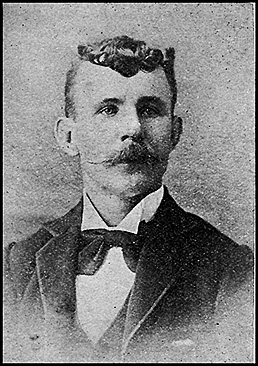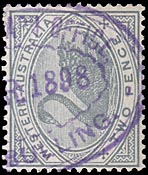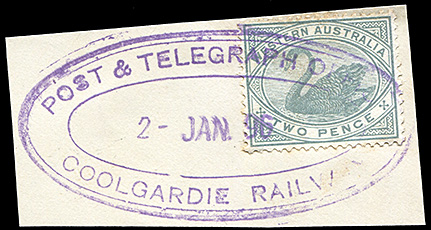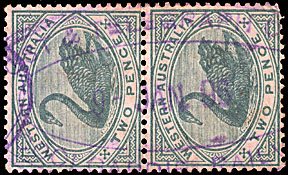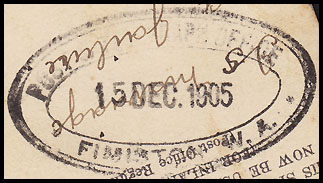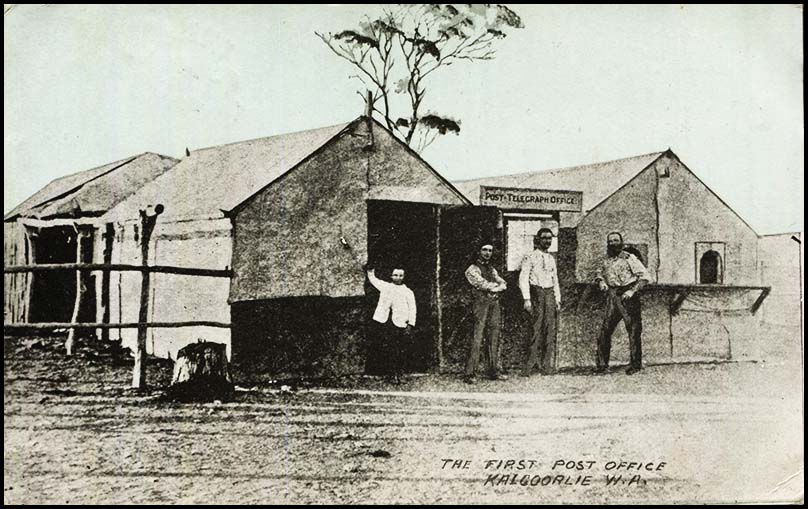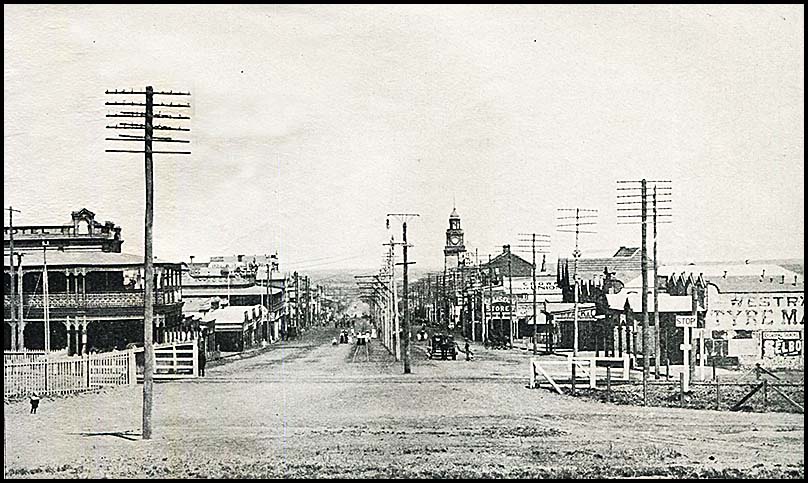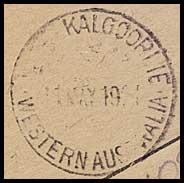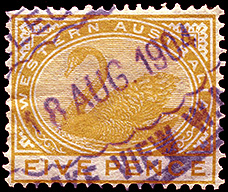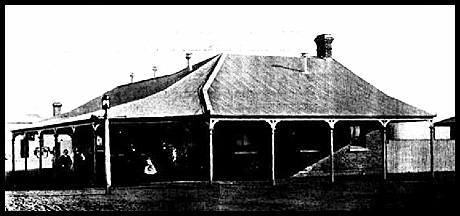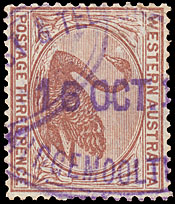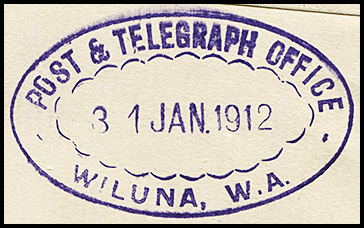Telegraph Offices in the Goldfields region.
- Australia 1901-1988
- New South Wales
- Overview of NSW
- Telegraph lines
- Telegraph Offices
- Date stamps
- Forms
- Envelopes
- Instructional annotation
- Collect
- Delayed
- Free
- Immediate Urgent
- Reply paid
- Rates
- Stamps
- 1871 Telegraph stamps
- 1885 proposal
- 1893 proposal
- Queensland
- South Australia
- Tasmania
- Victoria
- Western Australia
- International
- Special aspects
The Telegraph Offices in the Goldfields Region of Western Australia accessed from this page are:
In relation to the names on many places on the Goldfields, the Inquirer of 24 April 1896 made the following comment:
"The remarkable nomenclature of the mining fields in West Australia is gradually changing. I.O.U. has become Bulong; White Feather is now known as Kanowna; and Broad Arrow has just been changed to Kurrawah. But 'Black Flag' — most horribly suggestive name of all — remains".
An aside comment on opening hours for various Telegraph Offices in the Goldfields is appended.
|
Bardoc was located about nine miles north of Broad Arrow. A Receiver of Mail Bags had been established there on 1 January 1895. On 3 April 1896, The Inquirer conveyed the news that "The Crown land within a radius of two miles of the Post Office at Bardoc has been proclaimed a State fores, and the cutting of timber within the area is prohibited". The telegraph line was opened to Bardoc on Friday 10 July 1896 when delayed supplies finally arrived. It was downgraded to an Administrative Office on 1 August 1908. The Kalgoorlie Western Argus of 16 July 1896 reported "The telegraph line to Bardoc was opened on (last) Friday morning for the transmission and receipt of messages. The operators' quarters are in a temporary building on the new townsite but a permanent Post and Telegraph Office will be erected without delay". Bardoc is situated between Kalgoorlie and Menzies along the Goldfields Highway - about 45 kms (30 miles) from Kalgoorlie. The town's name is Aboriginal in origin and is taken from a hill close to town. The word barduk means near or close in the local dialect. In August 1896, the Broad Arrow Standard described the place as follows: "Bardoc is looking up. The town site has been cleared and buildings are being ran up on all sides. The fact of there being a 200ft. bore within a mile of the town with 40 feet of water in it should ease the minds of residents as to the water supply in the coming summer, and lends one more attraction to a prettily situated and rising town". Personnel: July 1896: Mr. G. Fenaci was appointed Acting Post and Telegraph master at Bardoc. December 1896: Mr. A. J. M. Cook was appointed as Linesman |
| There is no record of a special date stamp for use with Telegraphs being allocated to this Office. |
| Black Flag
Black Flag was located in the Broad Arrow Goldfields about 10 miles south west of Broad Arrow. "Between Broad Arrow and the 'Flag we have the Dead Finish and the Fag End. At both of these places, alluvial miners are making wages. Not later than last week a 60 oz. nugget was found at Fag End. Now we've come to the Black Flag — the largest district about here — that is if one can judge from the number of men employed and the amount of machinery in course of erection. Three hundred men are employed on one mine alone. " (W.A. Record 18 July 1896). In January 1896, some rich specimens that had been recently found at the Devon Consols mine at Black Flag were on display in the window of the Commercial Bank in Coolgardie. The largest piece - named "The Joker" - was beautifully shaped and it weighed 303 ozsAbout 8.6 kgs!! - one of the largest ever found in W.A.. The "I had a dream" story of its find and the lead-up is told in the Norseman Esperance Guardian of 7 March 1896. In March 1896, the Government divided the East Coolgardie gold field into two parts. Black Flag became the centre of the new North-East Coolgardie field which comprised the districts north from the Black Flag, north and east from the I.O.U. and up to Mount Margaret. March was a busy month - almost equally as important as the above, Black Flag opened its own racecourse in March 1896 and, at the Jockey Club’s July meeting carried our under W.A.T.C. rules, the riders were ordered to wear their own colours. "The Black Flag people are also complaining that, although the telegraph line has already reached and passed their town, they are as yet unprovided with a telegraph office and have to come to the 25-Mile in order to communicate with the outside world" (Western Australian Goldfields Courier 20 June 1896). And still: "Much dissatisfaction is expressed by the residents of Black Flag on account of the delay caused in the opening of the local telegraph office. Strange as it may appear, the blame in this instance does not rest with the Telegraph Department, as the necessary material and instruments for the office were despatched from Perth several weeks ago. They have, however, been subjected to considerable delay in transit; hence the trouble" A second explanation which differs from the first of less than 2 weeks earlier: "It appears that a new telegraph line was constructed to Black Flag over a month ago, yet no office has been opened, although the district is a large one. The residents appealed to the Postmaster-General for an operator to be sent up and he, it is stated, replied that, if the residents would erect a temporary office, a man would be sent. An office at the expense of several people in the district was immediately erected and the Postmaster-General was immediately informed accordingly - but so far no reply of any kind has been sent to them. Meantime, an office has been opened at Bardoc, a smaller township further away on the same line of country" On the same day, even further salt in the wound: "People at Black Flag are bitterly complaining of the neglect of the Telegraph Department to open communication with that place. As the line goes through the town, and the people of Bardoc and Broad Arrow have already been accommodated, the people very justly feel themselves aggrieved". On 16 July, Mr, Sholl was asked by the West Australian about the Black Flag delay and replied that "the matter had already been attended to and an operator had been despatched to open the Office". The W.A. Record of 18 July published the following: "in the Arrow and Bardoc we have neither telegraph offices nor operators. The men of the Flag have, by public subscription — the great sum of £15 was collected — built a hessian building (what must its size be?) to act as a Telegraph Office, and were bold enough to forward (their informant tells me) a wire to the Minister, informing him that a telegraph office had been erected by public subscription and further, humbly inquiring if they were expected to supply the operators and instruments". 18 July is the official date of opening of the Black Flag Office. On 26 August 1896, the Broad Arrow Standard reported that "The new Post and Telegraph office at Black Flag is fast nearing completion, giving that township a settled look". And then, on 5 September 1896, the Western Australian Goldfields Courier published "Mr. Mercer, the local officer of the Public Works Department, notifies that the new Post and Telegraph Office at- the Black Flag township will be ready for occupation in a few days from the present. The structure is of wood and iron and presents no special features". On 10 July 1897, the Government Gazette listed, amongst the reserves that had been set aside, 7 acres in Black Flag for Police, Post and Telegraph, Warden's Office, public utility and the Weslean Church. In the 1898 Christmas publication of the Post and Telegraph Department, Black Flag is credited (p.20) with "a Post and Telegraph Office, Police Station and six hotels for a population of 310 with about 400 within a radius of 3 miles". The Telegraph Office was closed on 4 April 1907 but re-opened on 1 July 1907 but then closed permanently on 24 February 1908. The two largest mines in the area - Black Flag and Lady Bountiful - had closed in 1906-1907 and so the town closed down soon after. As an aside - but in the realm of philately (at least stamp duties) - the Coolgardie Mining Review of 11 January 1896 relates this remarkable historical fact:
In July 1896, another Black Flag had an opportunity to shine. |
||
Personnel: July 1896: Mr. T. Coles was appointed Acting Post and Telegraph master at Black Flag. |
||
| The Office was issued with an rubber oval TELEGRAPH OFFICE date stamp: | ||
|
 29 August 1896 - about six weeks after the P&T Office opened. |
|
|
A Post & Telegraph Office was opened at Bonnievale on 23 December 1897. It was downgraded to an Allowance Office on 1 September 1909. On 26 November 1897, the Coolgardie Miner informed its readers that "At the present time, Bonnievale township possesses one hotel. Lately, however, permission has been given to another publican to transfer his premises to the locality and five other applications for licenses are listed to be heard at the next sitting of the Court. This is the best sign of progress". On 1 November 1902, the Coolgardie Miner commented that
|
|
| The Office was issued with a Post & Telegraph Office oval date stamp (RO6-P&TO): | |
|
 2 May 1899. |
|
 16 March 1907. Detail of the oval on the cover below. |
3d red-brown registration envelope (indicium on reverse flap) used from Bonnievale to Malhausen, Germany. Has
1d and 4d adhesives added on the front. On the reverse side, there is an oval "Registered/Perth, WA" date stamp in blue. |
|
| Boorabbin.
The Telegraph Office was opened on 24 September 1894. The Post & Telegraph Office was then opened in 1902. Boorabbin is about 65 miles (100 kms) north west of Coolgardie and halfway between Southern Cross and Coolgardie. It was a stopping place for teams travelling from Southern Cross to Coolgardie. As a demonstration of the importance of Boorabbin to the communications for Coolgardie, the Coolgardie Miner of 21 April 1894 reported that "The weekly mail arrived here at the very early hour of one o'clock yesterday morning, doing the distance from Boorabbin in 9¼ hours. The total weight of the mails matter was 1½ tons". In April 1894, the lack of water on the track severely impeded movements. The Coolgardie Miner of 12 April published the following: "We learn that all water has given out on the road from Boorabbin to here, thus enforcing the movements of the coaches which arrived here yesterday. Forty six teams have been stopped at Boorabbin and only one team is to be allowed to leave every 24 hours until rain falls, the traffic being regulated by the Government. As a consequence, the price of chaff has gone up 30 per cent. and it is very likely that other stocks will move in sympathy". Such a situation highlighted the need for telegraphic communication to such a place as Boorabbin. As an example of the strategy which had to be used, The W.A. Record of 26 April noted "The Engineer-in-Chief received the following message by telegraph from Mr. C. Jobson. It is dated Borrabbin, April 22nd, 3:20 p m , and was sent on to Southern Cross by messenger: " Wells here practically dry, owing to number of teams watering. New well only yields about 159 gallons per day. This means that the road from Southern Cross to this place is not safe for more than four teams every twenty-four hours". Personnel: September 1894: Mr. Lambert, formerly of Adelaide, was appointed Post and Telegraph Master at Boorabbin. June 1895: Mr. F. W. Foweraker was appointed Post and Telegraph Master. December 1900: Mr. Ottaway, a "Telegraph Official", was transferred to Derby. The farewell function held before the adjournment "to enjoy themselves at the terpsichorean art" is reported elsewhere. |
|
The office was issued with a steel circular TELEGRAPH OFFICE date stamp.
|
 21 December 1912. Abacus June 2019, Lot 848. |
|
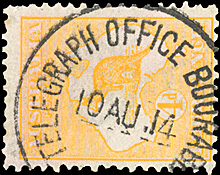 10 August 1914. Prestige June 2009 Lot 160. |
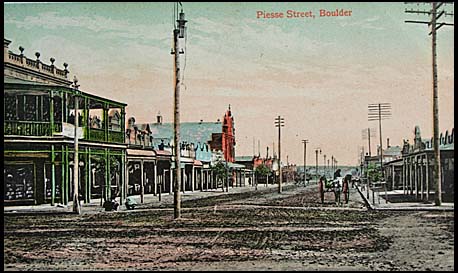 Boulder (Pleise Street) about 1900 showing telegraph poles. |
 Boulder Post & Telegraph Office about 1900. See the reverse side of this postcard and further discussion together with a rare Kalgoorlie oval date stamp elsewhere. |
|
|
 View of the Telegraph Office (on the right) in Burt Street, Boulder showing the telegraph wires.
|
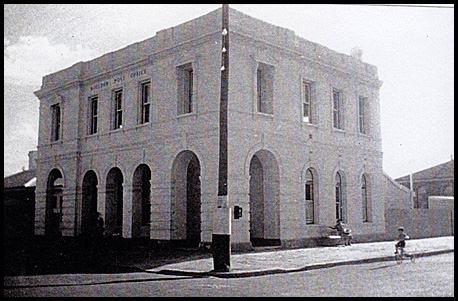 Boulder Post & Telegraph Office about 1950. |
The office was issued with four types of rubber oval office date stamp for use on telegrams. These were:
|
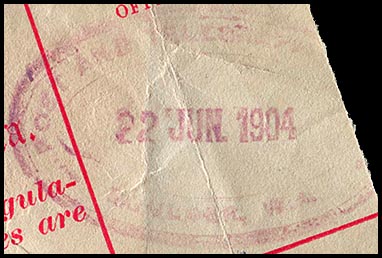 22 June 1904. |
|
 18 January 1911. |
 31 March 1914. Used on WI-DU-1. |
|
|
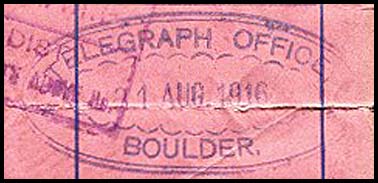 31 August 1916. Used on WI-DU-2.
|
Used 1944-47. |
|
Used: about 1976. |
|
| Broad Arrow (Kurawa).
The Broad Arrow Post & Telegraph Office was opened on 16 July 1896 - after delayed supplies for Bardoc, Black Flag and Broad Arrow finally arrived. During 1897-98, Broad Arrow was officially known as Kurawa. A most informative and direct description of Broad Arrow in 1896 is given elsewhere. Personnel: July 1896: Mr. F. Knight was appointed as Post and Telegraph Master at Broad Arrow. September 1896: Mr. J. Purling was appointed as Telegraph Operator at Broad Arrow. January 1897: Mr. J. G. B. Carr was appointed Telegraph Operator. |
||
| The office was issued with two types of rubber oval POST & TELEGRAPH OFFICE date stamps. | ||
|
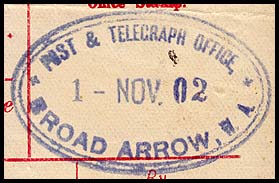 1 November 1902. Used on WC-DO-5B. |
|
|
 6 April 1918. |
|
|
The Kalgoorlie Western Argus of 4 March 1902 reported that: "Mr. J. W. Kirwan, M.P., has received the following letter from the Postmaster-General's Department: Melbourne, 18th February, 1902.: Sir, With reference to your representations urging that a new Post Office be erected at Brown Hill, W.A., I have the honor to inform you that £500 has been provided on the additional estimates of the Department of Home Affairs for the erection of a portable Post and Telegraph office at the place named. An Administrative Office was opened in October 1902. As might be expected, there had been a gold mine at Brown Hill. |
| Bulong (I.O.U.).
Bulong is about 40 kms east east of Kalgoorlie. The postal services had started in 1 January 1895. Mails closed at Hannans every Thursday evening at 10:00 pm for I.O.U. White Feather and Kurnalpi. The Post & Telegraph Office opened in temporary quarters on Friday 31 January 1896 after tenders for the Post & Telegraph Office had been called in October 1895. In April 1896, Mr. H. Parker was named as the lowest tender to construct the Bulong Post Office When gold was first found in the area in 1893, the group comprising 5 prospectors were granted a lease called I.O.U.. In 1894, Surveyor Hamiltion was assigned the task of surveying the area to design a township. He recommended that the name I.O.U. be changed to the indigenous name of a nearby spring called Bulong. It was mined until about 1908. In 1978, WMC sold their holding in the Bulong mine to Resolution Mining for nickel mining. Environmental and financial disasters followed. The mine has ceased to exist although the environmental consequences are still extant. . |
|
|
|
| Personnel:
January 1896: Mr J. N. Hawkins was promoted from Assistant at Menzies to be in charge of the new Bulong (I.O.U.) office. |
 Mr. J. N. Hawkins. |
July 1897: "On Friday evening last the Post and Telegraph staff at Bulong met in the new Post Office quarters to wish 'good-bye' to Mr W. F. Bleeck, who has been stationed at Bulong for the past three months as Telegraph Operator and acting-postmaster during the illness of the present Postmaster, Mr Hawkins. Mr Bleeck has now been promoted to the position of postmaster at Diorite King. Mr, Hawkins (Postmaster) occupied the chair, and, in the course of a neat speech, spoke of the valuable services rendered by
Mr Bleeck during his short term of Offce. He was, he said, very sorry to lose such an efficient and careful officer. On behalf of the staff he presented Mr Bleeck with a beautifully-chased gold signet ring as a small token of the esteem and good fellowship in which he was held. Messrs Nicholas, Chapman, Bain, A. B. Adams and Spence also spoke very highly of the many good qualities possessed by their guest, and all joined in wishing him every success and prosperity in his new position. Mr Bleeck, in responding, said he had been taken by surprise with the proceedings that evening, and words could not express what he felt for their kindness. He thanked them most heartily for their presentation and kind expressions. He was very sorry to leave Bulong. Although his stay had been short, he had made many friends, whom he hoped o have the pleasure of meeting again. A very enjoyable evening was spent. Several songs were rendered by members of the company" (Kalgoorlie Miner 20 July 1897). |
|
| The Telegraph Office was apparently issued with two formats of rubber oval date stamps for telegraph matters. | |
An RO6 - P & TO date stamp was issued with Bulong WA at the base. It was used in two colours:
|
 31 May 1899. On reverse side on an unclaimed registered cover from the Registered Office of Titles in Perth to Bulong with Dead Letter Office hand stamps. |
|
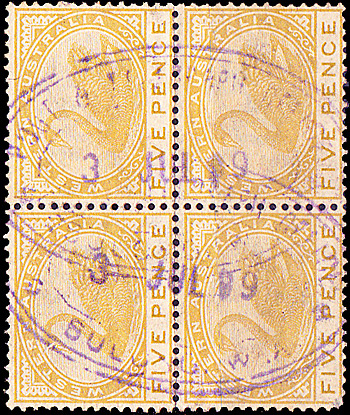 Bulong Post & Telegraph Office. 3 July 1899. RO7 - P&T in violet. |
|
A Receiver of Mail Bags operated from 1 September 1895. A Post and Telegraph Office was opened at Londonderry on 2 May 1896. On 23 March 1900, the name of the office was changed to Burbanks. The name of the township was changed to Burbanks on 15 March 1901. On 27 November 1897, the Coolgardie Miner reported "Burbanks is now one of the most progressive centres arcund Coolgardie. The proclamation of a townsite concentrated the population, and a thriving community is rapidly springing up ... Roads are required to be formed and a sanitary system was wanted, while the establishment of a post and telegraph office was declared indispensable ... Mr A. E. Simpson, the Secretary of the Progress Committee undertook to guarantee the particulars needed; and the information collected is sufficient argument it favor cf the claims of the new township. It was ascertained that the officials employed on the Burbanks Birthday Gift mine alone receive 1,200 letters a month, exclusive of parcels and a large number of private letters received by the miners and business people. Every fortnight postal orders amounting to £250 in value are despatched to the other olonies. Within a radius of a mile there is a population of 350, including 50 women and children. Less than three months ago only one small camp existed on the town site. Now there are five stores, three; boarding-houses, an hotel, a bakery, a butcher's, and twelve private residences". |
|
| A rubber rectangular date stamp RRH1-P&TO was issued to the Burbanks office in 1900. | |
|
 13 May 1903. Used on a WA Savings Bank form and the (just visible) black letters at the base make out the message "For person making first deposit". Image by courtesy of Malcolm Brown W.A. |
| Coolgardie.
The Post & Telegraph Office opened on 22 July 1894. It does not however appear that the two offices were co-located. The original location of the Post Office - opened in September 1893 - is not known. The first section of Coolgardie's Public Buildings, which included both a Post and a Telegraph Office, was completed on 3 May 1895 at a cost of £7,060. |
|
Details of the Coolgardie Telegraph Office can be found on various pages in relation to:
|
|
| As an insight into the the living and mining conditions in Coolgardie, the Australian Advertiser of 9 May 1894, noted that "Candles are so scarce at Coolgardie that they fetch half-a-crown a pound".
The construction and operation of the Telegraph Office(s). The 1894 Office. The Office which opened in 1894 appears to have been a shocker - both from its design and the ways in which it operated within its layout. Compounding the problems was the interference of Mr. Sholl, the Postmaster-General, and the inability of senior staff to be able to review work operations. Inappropriate skills and poor staff conditions and salaries compounded the problems. There were many articles highlighting the underlying conditions. One article recounts "a curious example of the parsimony of the Government was witnessed on Monday at the Telegraph Office. There was a total absence of ink for public use, and one disgusted man thought to shame the Department by purchasing and using a little ostentatiously. The only result was that it was rushed by the mob, and the purchaser was ousted from the use of his own ink. After a struggle he secured the bottle, remarking in triumph— "You may keep the ink but, by gosh, I'll have the bottle". He is keeping it now as a monument of Government extravagance" Another article, which is well worth reading to understand the Coolgardie situation through to the end of 1895, was published by the West Australian on 28 December 1894 - after the Offices had been operating for just five months!! The article starts: "The administration of the postal and other departments at Coolgardie has been pretty generally condemned, but the complaints so frequently came from t'otherslders that for time it looked as if the sweeping statements made were merely used with a view to showing how much better things are done in the eastern colonies. This, I am sorry to say, is not the case. As the result of careful observation during a stay of some weeks in Coolgardie and surrounding district, I am satisfied that complaints are more than justified, while the gross disregard for the convenience of the public displayed in some departments is such that it would not for one hour be tolerated in Perth or any of the old towns of the colonies. It is not owing to the economy or niggardliness of the Government that these abuses exist, but so far as I could learn they are chiefly traceable to the neglect or incapacity of the departmental heads" ... It is a very informative and reasonable read which suggests approaches to problem solving. On 30 October 1895, the Coolgardie Pioneer wrote: "The town or city (as its inhabitants love to call it) of Coolgardie is one which strikes the stranger with considerable surprise. Where three short years ago there existed only the lonely and dreary bush, varied by a very occasional native camp, there is now a large and opulent community, possessed of buildings and streets which would do infinite credit to many an elder settlement. The surveyors who planned out the town were wise in their generation, and as a result the streets are broad, and show to advantage the many handsome buildings ... The greatest handicap which Coolgardie has to endure at the present moment is the miserable inadequacy of the telegraphic service to cope with the incessant strain which is put upon it. When stockbrokers and financial agents are reduced to idleness, because they are unable to get telegrams through in time, it can readily be imagined what a source of loss, disaster and inconvenience, and what a check to progress is the present condition of the telegraph system". So nothing much had changed since 1894!! The Coolgardie Miner of 31 December 1895 noted: "Nothing phenomenal really occurred during the year, if we except the two disastrous fires which tore down large sections of Bayley Street. The black gaps are being covered with elegant buildings, which now adorn the main street and altogether the town has mightily improved in many respects, thanks to the town council. Taking everything into consideration, Coolgardie is now a clean, fairly healthy town. One public building is nearing completion—tbe Post Office—but it is such a ghastly structure that we wish old 1895 would cart it off to the limbo of the past. All round, the year of 1895 has been a good one for Coolgardie and has had more sunshine than gloom in its 365 pages". On 22 February 1896, a progress report in the 22 February 1896 Western Australian Goldfields Courier noted "The new Post and Telegraph Office, in course of erection, promises to be an ornament to the street. Mr. Riley, the contractor, is pushing on the work as speedily as possible". There were mixed opinions of the design - the Coolgardie Miner of 31 March 1896 noting as follows: "We have with amused interest watched the erection of the ghastly structure, and frequently speculated as to the purpose for which it was erected. Externally and internally, it is conceivably ugly, atrociously so, and reminds us of a very bad cross between a second-rate stable and an ancient West Australian gaol. It does not possess one solitary redeeming feature, and if it went off to Woolgangie through the exertions of a willy-willy, or suddenly disappeared into the earth, there would be tumultuous rejoicing". The 1896 Post and Telegraph Office. "The new Post and Telegraph Office has been opened for public business and is an ornament to the street, being one of the best buildings in the outlying districts" (The Golden Age, Calgoorlie, 12 May 1896). Clearly that office was not fitted out by May because, in the Western Australian Goldfields Courier of 6 June 1896, it is mentioned that "it is about time the new telegraph office was occupied". |
|
|
|
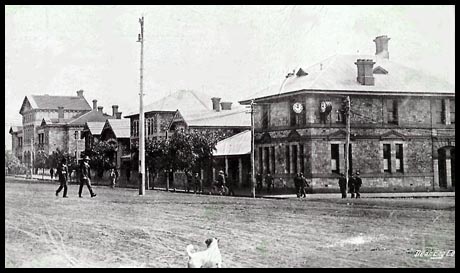 Coolgardie circa 1906. From a postcard. |
|
|
|
Finally, in August 1896, the telegraph office at last moved into its own building. The Inquirer of 21 August 1896 described the situation as follows: "Our Coolgardie correspondent reported August 16: The suite of apartments is spacious and well lighted, and is fitted with every modern convenience. The operating-room is 35ft. square and, like the receiving room, is the largest in Western Australia. In the operating-room accommodation is provided for 30 or 40 operators. The transmitting and receiving instruments are the finest that can be procured, the troughing for the wires being of the most approved pattern. The whole of the work has been done by day labor under the supervision of Mr. Mercer of the Public Works Department. No expense has been spared by the Government. The old building will, for the present, be used as quarters by the officials until some understanding is arrived at between the Postal Department and the Public Works Department, the land being in dispute". New offices were becoming a frequent event!! As a postscript to the construction of the new building, The Inquirer reported on 3 April 1896 that: "The public has wondered lately for what purpose a galvanised-iron building was being erected at the western end of the Supreme Court (in Perth). It appears that it is to be used as a Government office, and will accommodate a number of clerks who have been crowded out of some of the main buildings. The material with which the structure was built was, we understand, brought by the Government from Cue, where at one time it constituted the temporary Post Office. The Government was offered £650 for the material but declined to accept it. It, however, preferred to have it sent on to Perth at a cost considerably larger than the amount offered". The West Australian of 17 September 1896 reported: "Three additional telegraph operators for the Coolgardie station arrived to-day, and it is hoped this increase to the staff will do away with the delay and the public annoyance recently felt. Messages handed in at Perth on Friday afternoon were not delivered here until midday on Sunday, owing to the congested state of the line. The operators were kept working until five o'clock on Sunday morning, and when they knocked off they were thoroughly exhausted. The line between Coolgardie and Kalgoorlie is still very much congested, and delays are in consequence complained off.". "The context of Coolgardie and the surrounding major places must be appreciated when viewing developments. Certainly the people in the Goldfields felt isolated and neglected, The description of a Public Indignation Meeting held at Coolgardie on 8 October 1895 gives a strong insight into the mood of the people and the reasons for their feelings. The incredible strike by the Operators and Clerks at Coolgardie one month later was, in part, a testament to that isolation and the little understanding or empathy on the part of the senior bureaucrats - especially Mr. Sholl. The visit by the Premier Sir John Forrest began about one month later. On 9 October 1895, a major fire broke out in Bayley Street and destroyed a whole block of offices and shops including the Courier Office and the Reuter's Office. More buildings would have been lost without the assistance of many of the townspeople and the Afghans. Thanks to them "the Post and Telegraph offices were saved. The instruments were taken out of the building and communication with Perth was established by means of field instruments which were erected in the Police paddock" (Daily News 10 October 1895). The Geraldton Murchison Telegraph of 18 October 1895 reported as follows: "About an hour before the recent disastrous fire broke out at Coolgardie, Mr. Sholl the Postmaster - who is anything but a persona gratia on the eastern goldfields - was burnt in effigy and, as this performance was conducted in close proximity to Mr. Hinde's chambers where the fire originated, there is a belief which has been gaining ground from day to day since the catastrophe that the conflagration which terminated so disastrously was due to a spark from Mr. Sholl's bonfire".
The Telegraph Office at the end of 1896. Some disquiet was expressed by Coolgardians about the mail service about the middle of 1896 - so much so that they were agitating "for a coach mail in substitution for the camel service on the Coolgardie line". In September 1896, Premier Sir John and Lady Forrest visited Coolgardie were catching a special Coolgardie-Perth train. ne of the others in the official party was Mr. E. W. Snook, the Chief Inspector. While being entertained by the Post and Telegraph officials, Mr. Thompson (Post and Telegraph Master) proposed a toast to Mr. Snook. In reply, he noted that "although the staff at Coolgardie now numbered 70, it would soon be doubled. The business during 1894 and 1895 had increased 50 per cent, and the Westralian cable business was now greater than that of any of the other colonies". It is informative to obtain from the Coolgardie Mining Review of 26 December 1896, a review of the operation of the Coolgardie Telegraph Office: "In Coolgardie alone, the Post and Telegraph Department pay in salaries £1,000 per month, and the men all round are poorly paid considering the duties they have to perform.
The greatest number of messages ever transmitted from Coolgardie in one day was 900, the greatest number ever received was 950. The average number of messages transmitted per annum is 146,000, the average received is 182,000. The number of messages transmitted and received since the Coolgardie line was first opened is 975,000.There are now two simplex lines, three quadruplex and one duplex continually going. They use about 9 tons 12cwt.Converts to 9,610 kgs.of sulphate of copper per annum to keep the batteries going in the Coolgardie office. They repeat for Menzies, Kalgoorlie, Broad Arrow, Black Flag, Niagara, Coonalion, Goongarrie, Norseman, Dundas, Londonderry, Kanowna and Bulong. The fastest work done upon the Coolgardie line was prepared by J. J. O'Neil and C. Cutts, who topped all records with 70 messages and a Press in an hour. People in the East should be more careful with their addresses when telegraphing as no less than 5,000 telegrams per annum are undelivered owing to defective addresses". In their first meeting of the new century, the Coolgardie Municipal Council met on 18 January. One of the first issues discussed was that of the time at the Railway Station. "Cr Vance commented upon the glaring differences which were frequently shown between the times displayed by the clocks on the railway station and the clock at the post office. On one occasion lately, the railway time had been eight minutes in advance of the Post Office time which was the recognised standard time in the town and, in consequence of this discrepancy, several persons had been put to serious inconvenience. He had spoken to the Postmaster, Mr Thomson, on the subject and Mr Thomson had told him that he had, until recently, been in the habit of telegraphing the correct time to the railway station, but he had discontinued the practice when the officials at the Railway Station evinced a disinclination to take the trouble to receive his time message. Cr Vance moved that the engineer in charge of the local branch of the railways be asked to take the railway time from the Post Office in order that the public might not be misled". The West Australian of 16 April 1900 reported that on the previous day :
|
|
|
In 1894, the staff at the Coolgardie Post and Telegraph Office comprised:
It was proposed to increase this staff by 4 assistants to bring the total number of employees to 28. 1 September 1894: "Yesterday afternoon, just prior to the departure of the coach for Southern Cross, Mr. Frank Inkpen, the first postmaster of Coolgardie, was made the subject of the grateful recognition of the town of the manner in which he has conducted the postal arrangements of the field during the last ten months. Mr. Inkpen came here about ten months ago and, for some time, ran the postal service unaided as capably and successfully as could be expected under the unfavorable circumstances ...". The story continues in the Coolgardie Miner. September 1894: Mr. A. Barclay was appointed Senior Assistant. After about 12 months, on 23 November 1895, the Coolgardie Miner reported:
|
|
|
January 1895: Mr. E. J. Hackett of the Coolgardie office was promoted to take charge of the new office at White Feather. At the same time, Mr. Frank Peacock, an Operator at the Coolgardie Telegraph Office, was transferred to Perth. The Coolgardie Miner of 9 January 1895 applauds his service and suggests a reason for these staff changes. February 1895: W. Pleydell, J. F. G. Auricht and W. Doran were appointed as telegraph operators. March 1895: Mr. J. F. G. Auricht, Chief Operator at the Coolgardie Telegraph Office died suddenly at the Coolgardie Hospital this afternoon. He had only been a month here. He developed fever symptoms last week and went to the hospital three days ago. To-day, the Postmaster, Mr. Thompson, went to see him, when he said that he felt much better. While he was talking, he dropped back on his bed foaming at the mouth and died in a few minutes. Dr. McNeil was in attendance and pronounced the cause of death to be heart disease. Mr. Auricht was a very assiduous officer. He came from South Australia two months ago and was highly recommended by Sir Charles Todd. He became much respected during his short stay here (West Australian, 29 March 1895). It is interesting to note at this stage the comment by the Coolgardie Pioneer in August 1895 about Mr. Sholl, the Postmaster-General. (June?) 1895: Mr John Gerrans was transferred from Perth to Coolgardie as Operator and in February 1896, he was transferred as Post and Telegraph Manager to open the new office at Niagara. September 1895: Mr. T. Roberts, Telegraph Operator at Bunbury was transferred to take charge of the Coolgardie Telegraph Office. Beginning of November 1895: "Mr. T. H. C. Hill, who has just arrived from Perth to assist in the telegraph department here is the well-known baritone singer and Coolgardie musical circles will be stronger for his advent. He makes his debut on Sunday night at the Theatre Royal where, it is hoped, he will receive the welcome his reputation merits" (Coolgardie Pioneer 13 November 1895). |
| July 1895: Mr. T. G. Davey was appointed Chief Operator. | |
| "The Coolgardi office, although possessing some clever operators, has a few mediocre men as well. In such an important centre, where the telegraphing is necessarily very
heavy, every operator should be thorough, reliable and, above all, quick. Unhappily some of them do not possess these qualifications and consequently cannot, under the best of conditions, render good service.
In Mr. T. G. Davey however, the department has a worthy and able chief operator — one who is endowed with a remarkable amount of energy, and who discharges his responsibilities satisfactori]y and with uniform courtesy to everyone. Mr. Frayne at Kalgoorlie and Mr. Knight at Kanowna are likewise in their right places, being typical stamps of men for pioneer telegraphic work" (Inquirer 3 January 1896). 1 January 1897: the Coolgardie Miner reported that "Mr. T. G. Davey, the Chief of the local Telegraph department, who has also been down with fever is now on a fair way to recovery". |
 Mr. T. G. Davey, Chief Operator. |
THEN THE STRIKE OF NOVEMBER 1895. On 30 November 1895, the Coolgardie Miner reported the following comments made during Sir John Forrest's visit to the Goldfields: "Mayor Cohn, of Southern Cross, is a goodhearted fellow. This is what he said to the Premier at his reception in that collapsed mining centre: He was sorry that the postal and telegraphic officials had taken the stand they had in Coolgardie and the blame was not altogether on their shoulders, but it was due to certain political agitators that those servants of the Government had acted as they had done. It was an unheard of thing for Government servants to go out on strike. He hoped the Government would remember these men and, when they had capable men to fill their places, let them be told, as anyone would be in private employ, "We've had enough of you, now you can go". The Coolgardie staff who signed the letter requesting improved pay and conditions were: A. H. Bilbey, G. Chadwick, F. Rouston, F. H. Knight, T. Burton, F. Peacock, G. Ferguson, T. Roberts, H. Conder, H. H. A Woodgate, W. W. Williams, W. G. Hillhouse, J. M. Gowan, P. Sutcliffe, H. G. Phillips, A. F. Cahill, T. Swan, W. Sparrow and T. Lobb. January 1896 - (the nights of the long knives): "A presentation of a very pleasing character took place at the local telegraph office on Saturday evening when Mr. J. McGowan, the well-known telegraphist, was presented with a beautiful go/den souvenir and an address which read as follows: "Coolgardie, January, 1896. To Mr. Jas. McGowan. Dear Sir,—We, the officials of the post and telegraph offices at Coolgardie, Kalgoorlie, Kanowna, Menzies, and Coonalion, beg your acceptance of this slight token of respect in recognition of the valuable services you rendered to us daring the late trouble in our department and we trust that, in your new sphere, you will achieve that success which you richly merit. Again begging your acceptance, we remain, sir, yours faithfully, signed on behalf of staffs, S. Chadwick, W. H. Hodges, J. P. Cahill, T. Bruce". Mr. McGowan was President of tbe association during the late trouble which terminated in favor of the officials. He has, however, since that period, retired from the service on principle and the department thereby lost an able and valuable servant. Mr. McGowan, who left Coolgardie yesterday, takes with him the best wishes of many friends here for his success" Coolgardie Pioneer 13 January 1896). July 1896: Mr. T. H. Vallis was appointed as Telegraph Assistant; August 1896: Messrs J. Middleton, E. Laker and W. H.Tucker were appointed Telegraph Operators. December 1896: the staff at the Coolgardie Post and Telegraph Office comprised:
Also see above for salaries, performances, etc. December 1896: Mr. F. J. Heagney was appointed as a Telegraph Operator. June 1897: Mr. J. J. O'Neill, Telegraph Operator, resigned. October 1897: Mr. Francis Davison of the Telegraph Office was hospitalised with influenza. February 1898: "Mr K. H. Innes, formerly Postmaster at Geraldton, and lately appointed to the important position of Inspector of Posts and Telegraphs in Coolgardie, has now taken up his residence in the new quarters provided in the Post Office buildings and entered upon his duties. Mr Innes is an old and valued officer of the department, having served 26 years. His family at present are at Albany, but will come to reside permanently in Coolgardie as soon as the temperature becomes milder". September 1902: "At a well attended meeting of the Post and Telegraph cricket club, held in the club rooms last week, the following officers were elected:—Patrons : Messrs G P Stevens and J J Lloyd, President: Mr A Thomson. Vice Presidents: Messrs T G Davey, J Leslie, and H Butler. Secretary : Mr A Coulton. Treasurer; Mr C Cutt. Delegates to Association: Messrs C Field and P Jones, Mr Nelson has kindly donated a gold medal to the best all round player (P and TCC) should a Wednesday or Saturday Association be formed. The list of members is a lengthy one and, with the advent of new blood recently transferred to the Coolgardie office, the season promises to be highly successful". April 1903: "The Coolgardie Recreation Reserve presented an animated scene yesterday, on the occasiion of the sports gathering of the local postal and telegraph officials. Almost the whole of the staff were present and took part in the various racing events which were run. The success of yesterdy'a gathering was of such a nature as to stimulate the officers to make the affair an annual one. Last evening a smoke social was held at the club rooms, at the rear of the Post Office, and a splendid evening's amusement was carried out. The postmaster (Mr A Thomson) presided, and the whole musical and elocutionary talent of the Post and Telegraph Office was displayed to the manifest pleasure of visitors" (Coolgardie Miner 11 April 1903). 5 August 1926: The position of Messenger at the Coolgardie Telegraph Office (held by Mr. E. C. Harper) was abolished and gazetted.
|
|
The Telegraph Office at the Coolgardie Railway station was also issued with an oval date stamp The Office opened in September 1895 and closed on 19 May 1896. The Western Mail of 13 March 1896 reported:
There are five recorded examples of the date stamp RO6 - P&TO - all used in early 1896 (rated RRRR) before the opening of the Railway Station. |
|
Prestige Philately August 2010 Lot 506. |
Previously considered that only this part strike existed. |
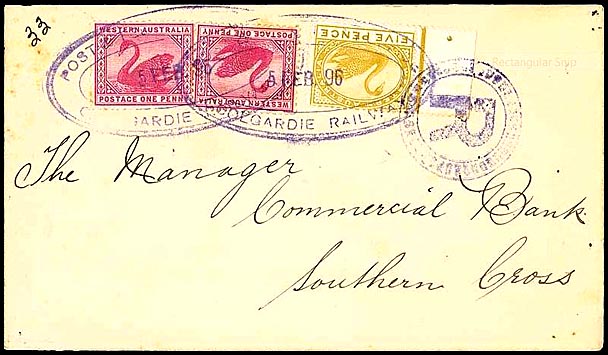 |
Coolgardie Railway Post & Telegraph Office. 5 February 1896. Double rate envelope registered to Southern Cross. Spink 19 May 2015, Vestey Collection Lot 485. |
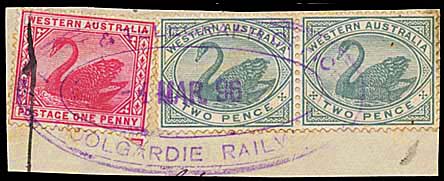 Coolgardie Railway Post & Telegraph Office. 4 March 1896. Prestige Philately August 2011 Lot 535. |
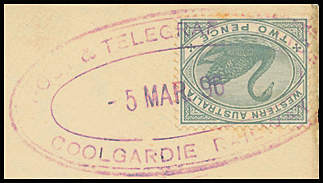 Coolgardie Railway Post & Telegraph Office. 5 March 1896. Prestige Philately December 2010 Lot 542. |
|
See Kunanalling. |
|
The mine is located about 30 kms north of Leonora. The town was later renamed Kurrajong. The Western Australian Goldfields Courier of 19 June 1897 reported "Two teams passed through here last week with timber for the Diorite King Post Office. It is around this district that the blacks have been so troublesome, - spearing horses and stealing "tucker" besides going as far as to tap a white on the head with a nulla-nulla". The Post & Telegraph Office opened on 15 July 1897 - three days after the line from Leonora had been completed. It was closed on 31 May 1901 but reopened as a Receiving Office on 17 June 1907. On 8 September 1897, the party who constructed the telegraph line to Lawlers (via Diorite King) passed through on their return to Coolgardie. Three hundred camels were expected through the following day on their return after taking loading to Lawlers. Snell Brothers of Menzies had commenced the erection of a store - making the third in the town. Personnel: July 1897: Mr. Bleeck was promoted to be the first Post and Telegraph Master after having served three months relieving at Bulong for Mr. Hankin who had been ill. |
|
The office was issued with a rubber oval POST & TELEGRAPH OFFICE date stamp (RO7-P&TO):
|
|
|
A Post & Telegraph Office was opened at Dundas (below Norseman) on 3 June 1896. Unfortunately the Office was destroyed by fire on 19 May 1895. A straight line DUNDAS handstamp is recorded but the date stamp was presumably destroyed in the fire. |
|
Tenders for the Post & Telegraph Office were called in October 1895. "The Ninety-Mile, or the Roaring Gimlet as it was formerly styled, now blessed with tbe euphonious title of Goongarrie, is rather a picturesque locality. The township, at present, consists of one hotel and two or three stores which front upon a scrubby thoroughfare of loamy soil, invariably about six inches or a foot deep in dust and decidedly unpleasant to the pedestrian as well as providing severe tax upon cattle. The hotel itself is one of the finest on the field outside Coolgardie" (Coolgardie Pioneer, 9 October 1895). The Post & Telegraph Office opened in temporary offices on 26 November 1895 when 90 Mile changed name to Goongarrie. It had originally been named 90 mile because of its distance from Coolgardie. The opening was at the time the Premier John Forrest was making his special visit to the Goldfields following the Coolgardie strike. The Inquirer of 3 January 1896 reported "The Goongarrie operator, who opened the office for business just as the Premier arrived, was quartered in a tent which afforded him but little shelter from the heat of the sun, and certainly no protection from the dust and flies". In December 1896, there were two operators assigned to the Telegraph Office. In November 1897, Mr. H. Gregory, the Member for North Coolgardie asked the Postmaster-General to open a Money Order Office at Goongarrie. Gold had been discovered in May 1893 by a prospector named Frost. The townsite was proclaimed in June 1895. |
|
| Two formats of rubber oval TELEGRAPH OFFICE date stamps were issued to the Goongarrie office: | |
|
 formerly 90 mile Torsten.jpg) 5 March 1896. |
 30 January 1897. |
|
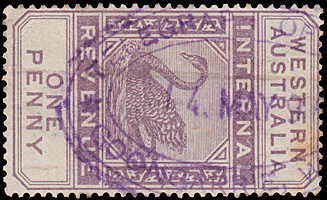 14 May 189?. |
|
|
 17 March 1902. |
| Gwalia.
The Telegraph Office opened between 1903 and 1915. Gwalia is located just below Leonora (see article below). The name is taken from the ancient poetic name for Wales - from whence Thomas Tobias (who registered the lease for the Sons of Gwalia in 1896) had originated. Further details of the mine (including the remarkable work of the future U.S. President Herbert Hoover (1929-1933)) are included on the Shire of Leonora website. |
|
| A rubber oval date stamp (RO4-P&TO) was used at the office about 1915.
Size: 25 × 42 mm (e = 0.80). Only one recorded use. |
 12 May 1915. Used on the flap of a OHMS registered envelope sent from Perth to Gwalia on 10 May 1915 but unclaimed and returned to Land Titles Office on 16 June 1915. |
Kalgoorlie Miner 31 July 1902: The recent visit of the Surveyor-General has been the means of arousing keen interest in the matter of a townsite here but, had the residents taken up the matter earlier and appointed representatives to meet the gentleman in question, it would have been more to their credit and they would have stood a much better chance of getting what they desire. True, Messrs. Dockendorf, Alderdice, and Mowat - members of the progress committee - did wait on the Surveyor General, but as they had practically nothing definite in the way of resolutions from the residents and were not even unanimous on the matter themselves, they could hardly be expected to make a good impression. Mr. Johnstone was practically left to the tender mercies of the Leonoraites, who naturally did their level best to convince him that it gave the Gwalia residents no end of pleasure to trudge five miles for their letters or for a draught of fuel oil or anything else that cannot be obtained nearer town. Under present conditions it would certainly be a big knock to Leonora if a townsite was granted to Gwalia. If the Tower Hill line and the shows north of Leonora develop up to expectations, Leonora could afford to lose the bulk of the Gwalia trade. The ?? could have raised a great cry about vested interest, but that is a term that fairly stinks as far as the mining community is concerned and threatens to eventually kill the goose that lays the golden eggs, a subject that was ably dealt with in a recent article in the Kalgoorlie Miner. However, it does not follow that because the fields are fleeced so shamefully to build up the farming and other coastal industries, the people of Gwalia are to quietly submit to being taxed and placed to no end of inconvenience for the sake of a few townspeople. The extension of the Leonora boundaries so as to take in about a mile or two of country between Leonora and Gwalia has already caused trouble to prospectors and it would be a very short-sighted policy to have residential blocks on what is known to be auriferous ground. The Sons of Gwalia Company hold two 24-acre leases north of the Rochester - Gwalia and, although the Gwalia lode has not been traced further north than the Rochester, it is only reasonable to suppose that the two leases mentioned will be worked some day. At present they are held by permission to concentrate the labor on the main leases. The Gwalia residents, or at least a large number of them, would be sorry to see Leonora "go bung'' and therefore are prepared to make some sacrifice for the sake of those who have spent their money in making the town what it is. There is little doubt that the lack of postal facilities is largely the cause of the agitation for a townsite at Gwalia and if post, telegraph, and money order offices were established, in all probability the agitation would soon die a natural death. A matter, however, which has to be settled is the question of a hotel and, on August 2, the residents are requested to say whether they are in favor of a license at Gwalia Block or a license near the A. W.A. Hall to be sold to the highest bidder, or a license near the hall to be controlled by the municipality. Gwalia offers an exceptional opportunity to test the idea of State monopoly of the liquor trade and the advocates of that principle expect a majority on Saturday. Attention has frequently been drawn to the failure of the officials to station police here, although they promised to do so months ago. If the department are only waiting for another outrage to be committed probably the police will be sent along shortly for a few nights since three suspicious looking individuals, said to be armed with revolvers, were surprised while apparently trying to force an entrance into the local railway station. The concert in aid of the A.W.A. Hall building fund promises to be a great success. The committee have arranged a first-class programme, the performers including Miss Olive Sharpe of Menzies. |
|
| Kalgoorlie.
The Post & Telegraph Office was established (in a temporary location) with the name of Kalgoorlie on 21 August 1894. Previously, a Post Office with the name of Hannan's had been opened on 11 February 1894 but it changed name to Kalgoorlie on 18 June 1894.
|
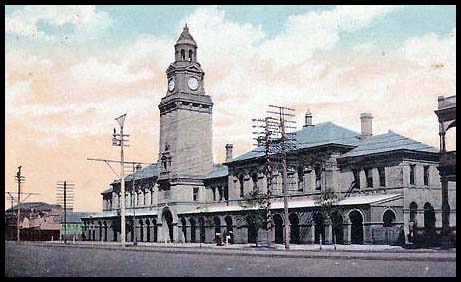 Kalgoorlie circa 1915. The new "wood and iron" building. |
|
|
|
|
Steps to raise that low standard for Kalgoorlie buildings began to be taken. In September 1895, tenders were called for the construction of a "wood and iron" Post & Telegraph Office at Kalgoorlie (Hannans). The following month, Mr C. Jobson and a staff were engaged to take levels and to mark out a site for the new buildings. Improvements were also being considered to other public buildings at that time. For example, the West Australian of 12 March 1896, reported an interview with the 28 year old Mayor of Kalgoorlie Mr, John Wilson. In part: "the most urgent requirement at Kalgoorlie is a commodious public hospital. At present the hospital work is carried on in Hessian tents which are wholly inadequate in every sense ... The next most pressing matter in the way of public buildings is the erection of a lock-up. The present mode of retaining persons who are arrested by chaining them to a tree is a barbarous one and should not be continued... On several occasions, the Police Court Bench has strongly commented upon the practice which has had to be adopted. To illustrate the hardship which this want entails, I should like to give the case of a man who was arrested recently as being of unsound mind and in whose case the Bench had no other course to adopt but remand the man to Coolgardie for confinement as the Magistrates considered it would be inhuman to chain him to the tree as is mostly done." A contract was called for erecting a temporary Warden's office, but the lowest tenderer refused to sign the contract and the second also was disinclined to carry out the work he had competed for. On 3 January 1896, the Inquirer updated its readers by noting that "the Kalgoorlie (Telegraph Office) officials work in a tent under very trying conditions indeed".
On 21 May 1896, the Kalgoorlie Western Argus noted improvements in the town as follows: "Very extensive additions to the temporary Post Office are about to be made and it is quite time. The business being done in the present small structure is enormous. The money orders alone issued every month amount to £80.000 while the telgraph business is the greatest outside Perth. The mails received and despatched every day are enormous while the staff, despite their being all good men, is quite insufficient to cope with the work. Two or three additional assistants for the Post Office are on the road from Perth, while the additions to the temporary office are to be put in hand at once. All day long a string of men block the entrance to the delivery office while waiting their turn to obtain letters from home and, on mail nights, the immense queue which forms in front of the delivery windows stretches into the street. It is high time a start was made to erect a big two story stone Post Office, as the immense sums of money and quantities of valuables passing through the post render it inadvisable to risk them in a temporary building. It is to he hoped a scheme of building which will make the most of the land at the disposal of the department will be devised as very little footage has been reserved for public purposes and, within a few months, the whole of it will be required. It is a noticeable fact that since the new splendid quarters have been occupied by the Post and Telegraph officials and the old bag shanties done away with, no cases of sickness have occurred among the members of the staff". In the WA Record of 18 July 1896 p.13
|
|
Personnel:
|
January 1895: "A most popular appointment has just been made by the Government to the staff of the local post office, Mr. J. F. Phillips having taken up his quarters there from Wednesday last. Mr. Phillips has been resident some time in our midst, having lately been in charge of Faiz and Taigh Mahomet's store, and is deservedly popular with the townspeople. He has had a long experience as Post and Telegraph master in S.A. and his services will therefore be found most useful not only to the public but also to the other officials. It was high time the office staff was increased, and no more suitable appointment than that of Mr. Phillips could have been made" (Western Argus, 5 January 1895).
The Kalgoorlie Western Argus of 26 September 1895 reported "An indignation meeting attended by about twenty-five persons, was held at the Australia Hotel last night to protest against the treatment received by Kalgoorlie at the hands of the Post and Telegraph Department. Speeches were made by the chairman and Messrs McDonough, Hargan, Fox, Linton, Parsons, Brown and White, condemnatory of the action of the Government in not providing enough officials at the Post and Telegraph Office and at the Warden's Court, nor enough office accomodation". 1896: Mr. J. H. Leach was Post and Telegraph Master. In October, he left Kalgoorlie to make an official visit to Kanowna, Kurnalpi, Bulong, Ballagundi and some other centres. February 1896: Mr. Charles Lamplough, aged 24 - an Operator at the Kalgoorlie Telegraph Office - died at the hospital from dysentery from which he had suffered for two weeks. He had been in the service for six months. One is reminded of the situation for operators at Coolgardie Telegraph Office. July 1896: Mr P. G.Hood was appointed as Junior assistant and Mr. A. Sholl was appointed as Assistant. September 1902: Mr. J. C. Muir, the Officer in Charge of the Electric Telegraph Office at Kalgoorlie exchanged with Mr. Richardson at Fremantle for a short time but then both returned to their official positions. July 1906: Andrew Thomson, Postmaster, Boulder, Clerical Division, Class 3, to be Postmaster, Kalgoorlie, Clerical Division, Class 2, as from 1st July, 1906. |
|
Four rubber oval date stamps appear to have been issued to the Kalgoorlie Telegraph Office:
|
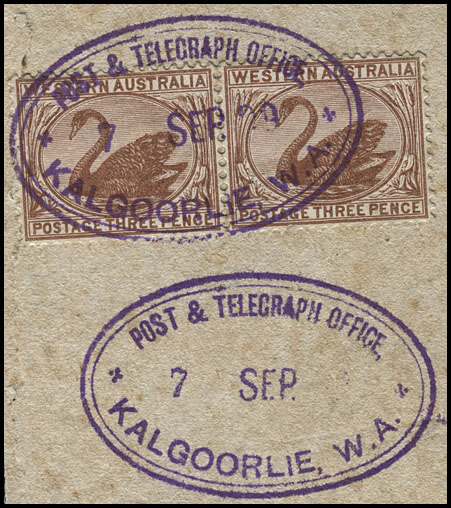 7 September 1899. Two strikes in violet of the RO2-P&TO date stamp. |
| The second example of the RO2-P&TO strike.
Double strike on a block of 6 1d red Swans. |
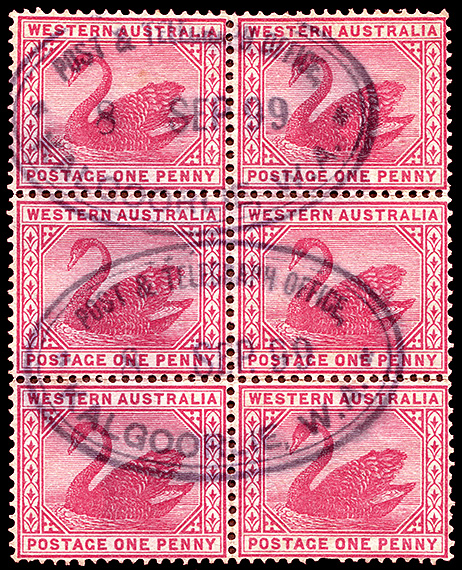 8 September 1899 - two strikes. ACE July 2018 Lot 932. |
|
 29 June 1903. Used on WI-DO-1. |
|
 4 September 1903. |
|
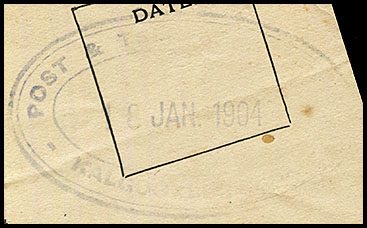 18 January 1904. Used on a Postal & Electric Telegraph Department receipt for telephone rental. |
|
Image by courtesy of Malcolm Brown W.A. |
|
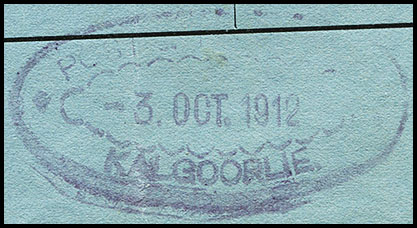 3 October 1912. |
|
 30 June 1914. Used on a Postcard (see below). |
 The reverse side of the postcard with the above RO4 - P&TO oval date stamp. The front of the card shows the Boulder Post Office with a comment comparing the two Post Offices. |
|
A steel date stamp inscribed TELEGRAPH OFFICE with KALGOORLIE W.A. at the base (SC1-TO) was issued to the Office:
A steel TELEGRAPHS date stamp has also been noted as being used in 1911 but it has not been seen (diameter 28 mm and rated RRRR). |
 10 December 1918. |
 5 February 1931. |
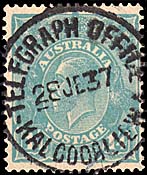 28 June 1937. |
 18 October 1946. |
|
A very rare date stamp is from North Kalgoorlie but with NORTH removed. That Post Office had operated in Ward Street and then in Campbell but closed on 21 June 1920. The date stamp had been used from 6 June 1906. The 28 mm diameter date stamp is known only on two early telegrams (Rated RRRR). |
Used on AE-DO-1Eb (printed on the scarce brown paper instead of green). |
|
Kanowna was originally known as White Feather after the gold mine which operated in that place. "Speaking of the Feather reminds me that
at the last meeting of the Progress Committee, exception was taken to the name the authorities have given the Feather. "Kanowna" is the name of one of the leases here, and why
it should be tacked on the place no-one appears to know. If the name had to be changed, and no good reason has been shown why it should, why should they neglect the native name, which is "Cowallillie". However, the committee decided to retain the old name, and have memorialised the authorities to that effect" Gold had been found in 1893. The White Feather Main Reef Company was formed in 1894. It was one of the richest mines outside the general Kalgoorlie-Boulder area. A Post Office had opened in October 1894 and closed in the 1930s. "I believe that the telegraph line is to be finished this week, and I have not the slightest doubt but what full advantage will be taken of it. We only hope that the office will be opened right away, and not wait for the sale of the township, which appears as far off as ever" (Coninuation of above Courier reference). Various newspapers noted that "The telegraph line is about to be extended to White Feather so as to place it in communication with Coolgardie" about the beginning of November 1894. A Post and Telegraph Office opened at Kanowna on 22 January 1895: "The White Feather Telegraph Office was opened to the public for the first time on Tuesday and Mr. S. A. Mott had the pleasure of sending the first message through the wires - the recipient being his brother at the Western Argus office, Hannans. Mr. Hackett, from Coolardie, has been placed in charge of the Post and Telegraph Office". (Western Argus, Kalgoorlie, 26 January 1895). "Without a doubt, the opening of the Post and Telegraph office here is a valuable acquisition and I am given to understand the takings in the telegraph office are very satisfactory up to date. There is a considerable amount of inconvenience caused through the want of a telegraph messenger for delivery of telegrams; another little item which is badly wanted is a Money Order Office. Perhaps your Progress Committee will take this up and be the means of these two little wants being granted" (Western Argus, 16 February 1895). |
|
| On 3 January 1896, the Inquirer updated its readers about the working conditions of the year old office by describing:
"at Kanowna, the Post and Telegraph office, save the mark, is absolutely the worst structure in that somewhat substantially erected centre". |
 Kanowna Post and Telegraph Office, 1896. Scanned from Souvenir of the Postal, Telegraphic and Telephone Departments of Western Australia, GPO Perth Christmas 1898. |
In 1905 there were 12,000 living at Kanowna - and there were 16 Hotels and two Breweries. Finding gold was the penultimate prize. The website Aussie Towns relates the story "At one point a man named Tom O'Connor found a staggering £15,000 worth of gold nuggets right next to the cemetery. Instead of respecting the dead, the local community decided the cemetery was a good place for prospectors. Amusingly the Methodist section was soft clay and easy to dig where the the Catholic section was quartz and needed to be blasted". Between 2006 and 2014, the Kanowna Belle Gold Mine was operated by Barrick Gold. In 2014, Northern Star Resources purchased the mine. |
|
| Personnel:
January 1895: Mr. E. J. Hackett of the Coolgardie office was promoted to take charge of the new office at the Feather. |
 |
Kunanalling (Coonalion or 25 mile). A Receiving Office was opened on 1 January 1895 about 25 miles from Kalgoorlie - and hence became known as 25 Mile. About the same time, a valuable discovery of gold was made at 25 Mile in January 1895. The Inquirer of 11 January 1895 reported "The 25-Mile is coming to the fore, the Premier line of reef being proved to be goldbearing for five or six miles. The last show there is from the lease held by a Fremantle company. The stone brought in from this property is simply splendid. It is solid reef quartz thickly studded with coarse gold, and it looks like one of the most important finds since the Wealth of Nations". Water and a large quantity of cement were also found in the general area. It had been intended that the Receiving Office would be renamed Coonalion but instead it was upgraded to a Post and Telegraph Office named the 25 Mile and opened on Monday 18 November 1895. A Township was declared in 1895 and called Coolalion although the name 25 mile persisted. In 1896, the town was gazetted and the offices were renamed Kunanalling. For further discussion and history of 25 Mile, see both Mining at the 25 Mile and 25 Miles Mines. A personal note written by Robin Goulder indicates that the Postmaster General's Annual Report for 1895 shows the spelling as Coonalion and that this spelling was also used in PMI. The 1896 Report shows the spelling as "Kunanalling (late Coonalion)". These descriptions fit with the above. The Western Australian Study Group - 1979 (edited by Pope) does not list a Telegraph Office operating at Kunanalling (pp. 382, 392) The Inquirer on 3 January 1895, in its review of condirions of the Telegraph Office which had been opened in the general area, noted "At the 25 Mile, the officer was far better off than his conferes (in surrounding Telegraph Offices) in the matter of accommodation, but he appeared to be overworked, having to despatch and deliver the mails and do the whole of the telegraphing as well". In December 1896, there were four operators assigned to the Telegraph Office at the 25 Mile. Kunanalling is now a ghost town. See the YouTube video on Kunanalling, Kanowna, Bulong and Kurnalpi prepared under the auspices of WA Here and Now.. Personnel: July 1896: Mr. Wm. Alfred Alt was appointed Assistant in the Telegraph Office at Kunanalling.
|
|
| A RO6-P&TO oval date stamp was issued to the Office - presumably in late 1895. It is incomplete and has the spelling as COONANALLI(NG). Goulder observes that the spelling in this date stamp "was presumably ordered before the name change.This is the first postal marking for Coonalion/Coonanalion". | |
|
 Undated. |
|
In early July 1894, many newspapers carried the story that "To heighten the excited feeling, news from Kurnalpi has come in to the effect that a 250-ounce nugget had been found at that field". |
|
The Post Office had been opened in December 1894.
Tenders for the Post & Telegraph Office had been called in October 1895. In April 1896, Mr. R. Tighe was named as the lowest tender to construct the Kurnalpi Post and Telegraph Office. The telegraph line to Kurnalpi was completed on 8 February 1896. The Premier received the first message sent from the Telegraph Office in the shape of a congratulatory message from the chairman of the Kurnalpi Progress Association. On Monday 24 February 1896, the Post and Telegraph Office opened in a temporary location. |
 The first Kurnalpi Post and Telegraph - as per the sign on the side of the tent. Scanned from Souvenir of the Postal, Telegraphic and Telephone Departments of Western Australia, GPO Perth Christmas 1898. |
On 15 August 1912, the postal arrangements were downgraded to an Administrative Office. The West Australian of 6 May 1896, described the town as follows: "This field is situated about 80 miles N.E. from Coolgardie, 56 from Kalgoorlie and 42 miles from Kanowna ... The town at present consists of a store (Messrs. Cable, Lardner & Jones), hotel (Mrs. Ames), Warden's office, Post and Telegraph office. Attached to the store are a baker's, a butcher's and a chemist's shop. This field was about two years ago the scene of an immense rush, and the heaviest alluvial gold found on the Coolgardie fields was picked up here. The population at the present is estimated at between three and four hundred, steadily increasing ... The opening of the telegraph line has been a great boon to the field and it is largely utilised. The Progress Committee meet once a week and, up to the present, have been fairly successful in obtaining a grant from the Government for public purposes. A new Post and Telegraph office, Police barracks, and Miners' Institute have been approved and tenders called for". Some type of oval date stamp was issued to the Office but it may have just been for the Post Office. |
|
| Personnel:
June 1896: Mr. H. B. Loughery was appointed as Assistant. |
 Mr. L. Nattrass, Messenger in 1896 - with his dog (standing nest to the tent). Scanned from Souvenir of the Postal, Telegraphic and Telephone Departments of Western Australia, GPO Perth Christmas 1898. |
|
An Official Office was opened on 19 February 1904 when the office was transferred from Trafalgar which had been opened on 6 December 1902. The Office was transferred back to Trafalgar in 1909. The Lake View and the Star Mine - as well as Fimiston - are located about 6 kms from Kalgoorlie and adjacent to Boulder. Good gold was struck at Lake View at about the end of August 1894. |
|
A rubber oval Telegraph Office date stamp (RO7-TO) was issued to the Office.
|
ACE Auctions, July 2018. |
|
The site was originally known as British Flag. Gold was discovered there in 1896. Dr. Charles Laver was a leader in the area and so, when the town was approved in 1898, the name was changed to Laverton. The Post & Telegraph Office opened at Laverton on 12 August 1899 on the closure of the office at Mount Margaret. A tri-weekly mail service between Malcolm and Lavertoon also commencd at about the same time. The newly created Laverton (and Beria) Mercury provided ((on 14 October 1899) a strong comment on the Laverton Post and Telegraph Office (which had been moved from Mount Margaret): "The authorities appear to be very long-winded in effecting the removal of the Post and Telegraph Office from Mt. Margaret to Laverton. There cannot be any reasonable excuse for this delay. The present temporary building in which the postal and telegraphic business is being conducted is altogether inadequate for the purpose for which it is being utilised and is simply a disgrace to the postal department. The building, which is a small hessian structure, evidently designed in the first place for a dog kennel is, irrespective of its incapaciousness and altogether unsuitableness, liable to be taken away at any time during the occurrence of strong willy willy. Nobody envies Mr T. McGladdery, the Postmaster, his position, which is attended, in addition to those already mentioned, by numerous other inconveniences which are too obvious to necessitate particularising". On 7 November the Laverton Board of Health resolved to write to the Postmaster-General "pointing out the existing inadequate facilities at the local Post and Telegraph office and asking him to appoint an assistant to the postmaster; also a telegraph messenger" (Laverton and Beria Mercury). A month later, on 9 December 1899, the Menzies Miner reported "A Money Order office opens at Laverton (12 December) and a branch of the Savings Bank will be opened within a few weeks". Laverton declined because of the low price of gold in the 1960s. But in 1968, Ken Shirley discovered nickel-bearig rocks about 24 kms north west of Laverton. That began the adventurous but disasterous Poseidon share boom and crash. There are still two gold minesOne mine is operated by Gold Fields and the other by AngloGold Ashanti. operating in the area. Personnel: December 1899: "Mr. J. Scott took up his duties at the local Post and Telegraph Office last week as assistant to Mr T. McGladdery, Postmaster Laverton. Although Mr. Scott is a stranger, who will doubtless eventually prove to be a popular resident, his appointment here is not only gladly felt by Mr. McGladdery, whose duties in the past have been altogether too laborious, but by townspeople and others". |
|
| Two rubber oval date stamps were issued to the Telegraph Office at Laverton for use with telegraph business. They were used concurrently. | |
|
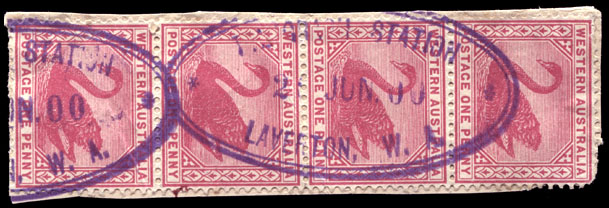 2? June 1900. |
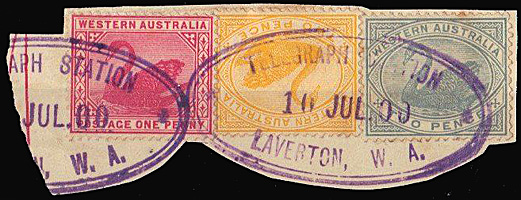 10 July 1900. ACE Stamp Auctions, December 2012. |
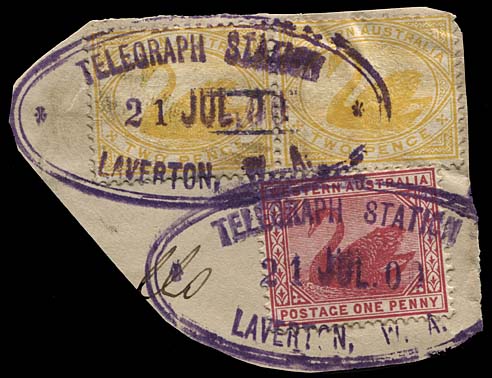 21 July 1900. Spink Sale: 21 April 2017 in Lot 2143. |
Used: 26 September 1899 and 17 - 19 July 1900. |

26 September 1899. (Earliest recorded date - about 5 weeks after the Telegraph Office opened). |
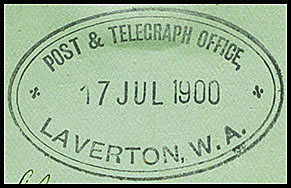 17 July 1900. |
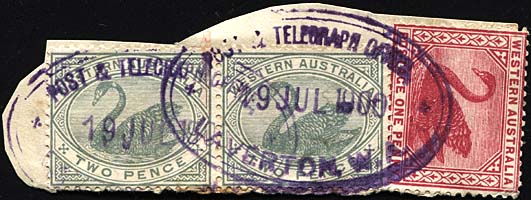 19 July 1900 (latest recorded date). |
|
The Post & Telegraph Office was opened on 30 August 1897. A Post Office had been opened during the previous year on 16 August 1896. In a review of the township, a correspondent for the Mount Magnet Miner of 17 July 1897 reported "The Post Office is a most commodious building of wood and iron and is now equipped with telegraph operating room and instruments". At its peak, Lawlers was the third largest town in Western Australia, It is now a ghost town. |
|
|
|
Two rubber oval date stamps were issued to Lawlers for use with telegraphic business:
|
|
|
|
| Menzies.
Menzies lies 92 miles north-west of Kalgoorlie and was the main town of the North Coolgardie goldfields. Gold was discovered in 1894 by Charles Hall. Mr. Leslie Menzie was the first to take out a lease beyond the 90 mile and called the mine the Lady ShentonThe Lady Shenton was owned by Menzie who represented a Perth syndicate plus other individuals including Sir George Shenton, H. Darlot and R. F. Sholl (the younger brother by one year of Postmaster-General Sholl).. He had formerly discovered and then became Manager of the Star of the East mine at the Murchison. In the mid-1890s, The town was gazetted as Menzies in 1895. Menzies was the terminus of the railway line. In 1896, there was a population of about 2,000 people but it would soon cater to over 6,000 people living within 2 mile radius. The town had 10 hotels, four churches and three banks. |
|
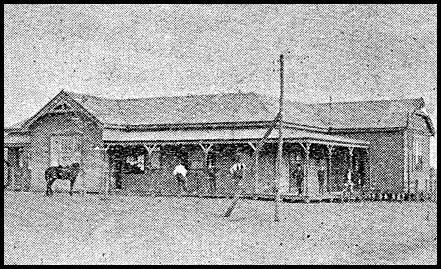 Menzies Post & Telegraph Office in 1896. Source: Souvenir of the Postal, Telegraph & Telephone Departments of Western Australia, Christmas 1896. |
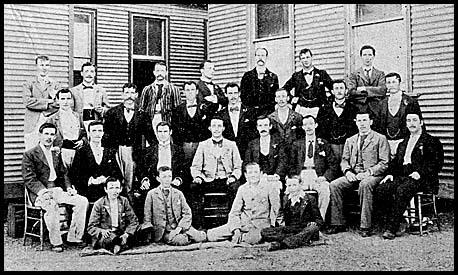 Staff at Menzies about 1894. Source: Souvenir of the Postal, Telegraph & Telephone Departments of Western Australia, Christmas 1896. |
Tenders to construct the Post & Telegraph Office were called in September/October 1895. The telegraph line reached Menzies on 3 December 1895 when the Post & Telegraph office was nearing completion. "The people of Menzies were taken by surprise on Tuesday, 3rd instant, when it was announced that the telegraph line connecting with Coolgardie and the world generally had been completed and a congratulatory telegram from the Premier had been received. A number of other congratulatory telegrams were also transmitted. Some of the people here have not been slow to abuse the Ministry for being apathetic but, if the Government carry out their other promises with the same spirit as the telegraph extension, no one here will have cause to complain. That the line will pay and be a great convenience to the public is vouchsafed by over 450 telegrams having been received for the five days. There is still, however, another small matter requiring the attention of the Postmaster-General, viz: to provide a lad to deliver the telegrams within a radius of two miles. It is difficult for people to know when they arrive and, those outside the mile, would only be only too glad to pay 2s. each for their delivery rather than lose time in running to and fro. Lads, however, are not to be procured in Menzies, probably one from Coolgardie would be available" (Coolgardie Miner 13 December 1895). During the visit of Premier Forrest to Menzies on 27 November 1895, the deputation was tasked "To point out to him the unsuitability of the building now being erected to do duty for a Post and Telegraph station". In January 1896, residents were angry at the great inconvenience caused by the lack of stamps at the local Post Office. No stamps at all were obtainable and the inexcusable negligence on the part of the Department was resented here. On 20 April 1896, the West Australian repprted the following critical news: "Illness of Post Office Officials at Menzies. Owing, it is said, to the insanitary state of Menzies, there has been considerable illness among the Post and Telegraph officers there. At one time no less than four men were down with typhoid fever. These were removed as soon as possible but still reports of cases continue to come in to the Postmaster-General who is afraid that if something is not done at once to render Menzies more healthy, he will be unable to get men to go there. Early on Saturday morning he received a telegram to say that the young man Johnson, who had contracted fever and had been suffering for some time, had died at 7.30. The Postmaster at Menzies, in notifying his chief of this sad event, remarked that he was getting disheartened in his endeavours to keep the business of the place going under such trying circumstances". On 11 August, 1896, duplex telegraph instruments were received at Menzies and an officer of the Telegraph Department arrived to install them at the Telegraph Office. Two additional operators also arrived (see below) bringing the total to 6 by December 1896. "The additions to the Menzies telegraph office have just been completed by the contractors Messrs. Hayward and Gray, and as a result the receiving operators were last night more comfortably situated. Instead of the postal and telegraphic work having to be done in one apartment, separate rooms have been provided in which the work of the different branches of the service can be carried out. This will undoubtedly prove advantageous to the public as well as the staff". (The Menzies Miner, 10 April, 1897). By 1897, there were five main gold mines around Menzies:
Personnel: October 1895: Mr. S. R. Roberts was appointed Postmaster at Menzies. March 1896: Mr Johnson, an operator in the Menzies telegraph office, unfortunately died from typhoid fever. He had only arrived in Menzies on 29 January and developed fever in early March. Two other operators from the same office, Messrs Shaw and Thornton, had to be taken to the Coolgardie hospital suffering from the same disease (see story above). September 1896: Mr. A. J. Parsons and Mr. T. Cain were appointed as Telegraph Operators at Menzies. December 1896: A. E. Greaves and E. J. Pearce were appointed as Operator and Assistant respectively. June 1897: "Mr. Perkins, who has been connected with the local Post and Telegraph office for the past 12 months, and who has been promoted to the Post Mastership at Mount Malcolm, was last night made the receipient of a handsome gold pencil case and set of gold sleeve links bv his ellow-employees as a token of the steem in which he is held. Mr. Fisher, the Postmaster, in making the presentation, expressed his regret at losing Mr. Perkins, who had always proved himself to be a competent and obliging officer, and he was sure the residents of Mount Malcolm would benefit by his presence amongst them. Mr. Perkins feelingly thanked the staff for their handsome presents. He would always value them, not alone for their intrinsic value, but also as mementoes of the happy time he had spent in the Menzies office. Mr. Perkins, who leaves by this morning's coach for his new sphere, carries with him the best wishes of all who knew him" May 1899: After a spell of nearly three years in Menzies, Mr T. Cane, one of the operators in the telegraph office, was proceeding to Perth. Mr Cane has, at his own wish, been transferred to Perth for three months, and during his absence, his place was filled by Mr McCabe, who was from the Perth office. |
||
Four oval date stamps were issued for Telegraph use at Menzies with all of them used concurrently in 1904:
|
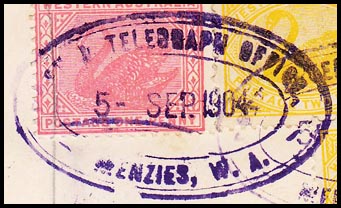 5 September 1904. |
|
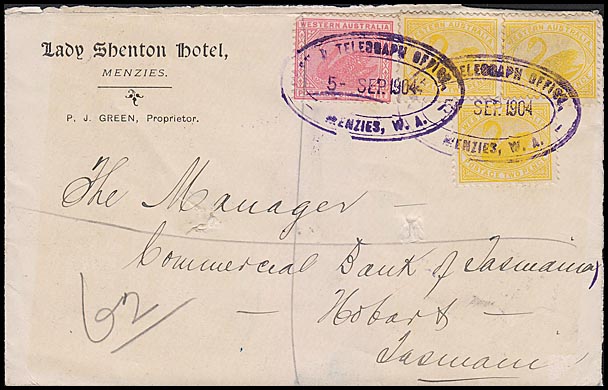 ACE Stamp Auctions November 2013 Lot 963.
ACE Stamp Auctions November 2013 Lot 963. |
Lady Shenton Hotel cover sent from Menzies to Hobart,Tasmania. 5 September 1904. Has two complete strikes of the Post & Telegraph Office oval date stamp (RO6 - P&TO).
|
|
|
 19 July 1904. |
|
|
 29 July 1904. Used on a Tattersall's cover to Hobart. |
|
|
 1 July 1915. |
|
The people on the Leonora Progress Committee always felt they were ignored by the Government (and it seems that their feeling was often justified). The North Coolgardie Herald of 30 September 1897 gave another example: "The new Post and Telegraph office is completed and, although not officially opened, we are able to use the telegraph which is a great boon though we will be unable to obtain such a small item as a money order, and will still have to travel to Malcolm, a distance of 14 miles for that purpose". On 22 October 1897, the Telegraph Office did (officially) open at Mount. Leonora together with the Post Office. |
||
In February 189, a deputation met Mr. Lefroy, Minister of Mines and asked him for several advances - one of which was a Telegraph Messenger!!! On 7 April 1899, a deputation from the town waited on the Premier. They had three requests:
On 10 July 1908, the official name changed to Leonora although it had been referred to as tht for many years (see the RO7 date stamps below). An interesting article appeared in The Evening Star (Boulder) on 3 September 1908:
The West Australian of 27 November 1908 reported:
|
Five formats for the oval date stamps issued to the Mount Leonora Telegraph Office are known. The first date stamp was inscribed Mount Leonora while the others (from 1900 onward) had the word MOUNT either removed or were produced as Leonora. All had the inscription Post & Telegraph Office: |
|
|
 10 March 1899. |
 28 August 1899. |
|
Also recorded:
|
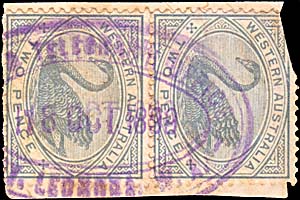 18 October 1899. |
Not recorded elsewhere. |
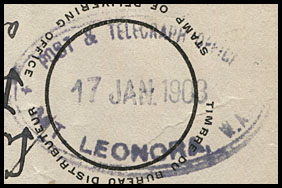 17 January 1902. Used on an Avis de Réception form. |
|
 10 September 1900. |
|
 13 August 1901. |
|
 15 Jan ?? - maybe 1914. |
| (Mount) Malcolm.
In his 1869 exploration, John Forrest (later Premier Sir John) named the place for the town after the nearby mountain. It is about halfway between the 90 Mile (Goongarrie) and Lake Darlot. A Receiving Office was opened at Mt. Malcolm on 1 March 1897. Soon after, the Post & Telegraph Office was opened on 15 June 1897 - also as Mount Malcolm. "The completion of the telegraph line to Mt. Malcolm was effected at 10 o'clock this morning (15th), when the following congratulatory wires were transmitted to the acting-Premier and Postmaster-General, Perth: — "The mining and business community of this centre congratulate the Telegraph Department on the completion of the telegraph line here, and also in the speedy erection of Post Office buildings. The extension of the tri-weekly mail service from Niagara to Mount Malcolm would prove of further benefit, and is greatly needed" In September 1897, approval of a public reserve in Malcolm was finally listed in the Gazette for the Post and Telegraph Office at Malcolm. The Malcolm Chronicls of 1 April 1889 reported the steady progress made at the Malcolm Post and Telegraph Office. There had been a steady increase in the Money Order business and a similar improvement in the telegraph department - with a 33% increase in business over previous reords., The Office was renamed Malcolm in 1904. It closed on 20 December 1950. The evolution of Malcolm can be summarised as follows:
Malcolm is now a ghost town. Personnel: June 1897: Mr. Perkins of the Menzies Post and Telegraph Office was promoted to be the first Post and Telegraph Master at Mount Malcolm (see Menzies entry).
Malcolm had been the centre of the Mount Margaret goldfields. The North Star Mine is near where Malcolm used to be (next to Leonora) and is now operated by Fortescue Metals Group . |
|
| The Office was issued with a rubber oval TELEGRAPH OFFICE date stamp (RO6-TO) inscribed Mt. Malcolm. Then, after the change of name, a new date stamp was issued inscribed Malcolm. | |
|
 13 July 1897. One month after the Post & Telegraph Office had opened. |
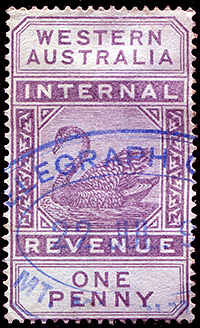 22 July 189?. |
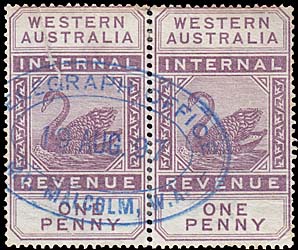 19 August 1897. |
|
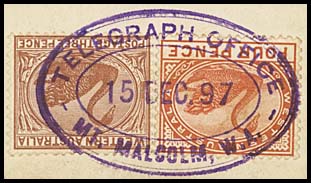 15 December 1897. |
|
Used on the reverse side of a registered OHMS envelope sent from Perth to Coolgardie and redirected to Murrin Murrin and then to the Dead Letter Office in Perth. The reverse side also has a similar RO4-P&TO date stamp in blue for Murrin Murrin. |
On 7 March 1896, the Kalgoorlie Miner reported that "Further results of crushings from the Little Wonder are to hand. The mine is situated about 15 miles from Doyles' Well, near Mount Malcolm. The first crushing of half a ton from the surface yielded 970 ounces of gold. A second crushing of 8cwt from the 70ft level gave 423 oz, and a third crushing from the 90ft level of 23cwt returned 1310 oz. The last crushing, which was from the 160 ft level, gave 250 oz from 48 cwt. Mount Malcolm is situated half-way between Ninety Mile and Lake Darlot or Lake Carey". The Menzies Miner of 13 February 1897, noted that "The Postmaster-General will open a money order office as soon as a bank opens and has ordered a building for a Post and Telegraph office to be erected in Malcolm forthwith. Unfortunately Mr. Beasley's survey has not yet been received here and the location of the Post Office is unknown".
On 19 March 1897, the Daily News reported that "A public meeting, attended by 700 persons in and around Mt. Malcolm, was held in front of the Mt. Malcolm Hotel in Star Street on Monday evening the 15th March ... (amongst other matters, the meeting urged) that the Government erect and open a Post and Telegraph office forthwith and that a bi-weekly mail service be established at once to this township".
|
|
|
A Post and Telegraph Office opened at Mount Margaret on 17 May 1897. In November 1897, Mr. H. Gregory, the Member for North Coolgardie asked the Postmaster-General to open a Money Order Office at Mount Margaret. Records show that a Receiver of Mail Bags had been established at Mount Margaret in August 1896. In the folowing month, the Western Australian Goldfields Courier of 12 September reported "The residents of Mt. Margaret have requested the Menzies MINER to draw the attention of the Government to the fact that great inconvenience has been caused by the distance of the Post Office from the townsite chosen by the residents and approved by the Warden. The Post Office at present is located in a store belonging to the Mt. Margaret Reward Company. The residents assert that this is over a mile from the townsite, and protest in a body against the continuance of the Post Office in the present locality". There is confusion with dates and services there but it cannot be sirted out at this time. HELP??? The Office closed on 7 September 1899. See elsewhere for some observations. |
|
A RO6-TO date stamp was issued to the Office.
|
 No date except 13 Ju?? (Could be only one of three years). |
|
Morgans (Mount Morgan) is east of Leonara on the way to Laverton. Gold had been discovered in 1896 and the township evolved nearby. A most wonderful recounting of the establishment of Morgans with the survey of the land and the organised rush of people wanting to peg claims for mining and for houses is given in the Coolgardie Miner of 7 March 1899 - The Battle of Morgansville. Gold has been produced at that place through four distinct periods up until 2020. A Post & Telegraph Office was opened at Mount Morgan on 10 August 1899 - fairly soon after the above-referenced Battle. The Menzies Miner of 26 August 1899 noted this development as follows: "We have at last the telegraph line — a great boon to the town. The temporary office is opposite the National Bank and the Post Office. The present position could not be more convenient to the people". The North Coolgardie Herald of 28 September 1899 - seven weeks after the P&TO had opened - gave its editorial description of events as follows: "It is marvellous how Government money is unnecessarily wasted in many of the branches of the Government Departments. Take the Post and Telegraph Office here for example. It was erected in the first place at a retired restaurant keeper's house at a rental of, I believe, a pound. Think of a Government renting a place when it, or its Representative, had the first grab to secure or reserve a few blocks for public purposes when laying out the town site! But the Representative, or more properly speaking the servant of the public, and more particularly the servant of the people of Mt. Margaret district did not, or perhaps does not, possess that amount of wisdom or forethought that he should show by having prominent and central areas Reserved for public conveniences. After having the said hash-house renovated, the telegraph wire laid on, the office furniture, etc fixed up and business put in full swing for a week or so, the the whole paraphernalia was shifted to a bough shed at the east end of the town and quite outside of the town site! The humpy is very conspicuous for insignificance and, if any person wants to find it, he has to ask a policeman. Now the time and expense taken up and wasted in fitting up the office and then pulling it down again and shifting it from one place to another, would have been ample to put up a live Post and Telegraph Office but not a hot-house shanty; and as the place at present stands, it is anything but convenient to the majority of the people residing on the town areas. Then, if the town should extend, which is very probable, it will not go the way the Post Office humpy indicates. Whilst writing on this matter, the public are greatly inconvenienced in not having a Money Order office in connection with the Post Office, also a savings bank. People find it very awkward when they wish to remit money through not having the office in question. It would therefore be a great boon to the public generally if the Government would grant us this little concession. We are justly entitled to it for obvious reasons. There is another little matter of oversight, or want of foresight, on the part of that slow-moving individual who has the looking after the comforts and accommodation of the Police in this district. We have here a good officer in charge, Constable John O'Loughlin, but he has not even a mulga bush to chain his captives to let alone the necessary statutes and forms to enable him to administer the law properly and expeditiously. Yet further, he has not even a house to camp in. Only for the hospitality of Mr. George Davis, he would be compelled to take the sky for a roof and mother earth for a mattress". On 9 December 1899, the Menzies Miner reported that "Mr Sholl states that a Money Order office and savings bank cannot be opened at Mt. Morgans until a suitable building is erected. The present building being wholly inadequate. However, the Works' Department is pushing on with the erection of a building as quickly as possible and, as soon as a suitable office is ready, the conveniences referred to will be provided". The town was renamed Morgans in 1909. It is now a ghost town. |
|
| One format of a rubber oval date stamp (RO2-P&TO) was issued to Mount Morgan. | |
|
 November 1899. (three months after the Office opened). |
|
Mulline is located north-west of Kalgoorlie and west of Menzies. Mulwarrie is about 90 miles (125 km) north-west of Kalgoorlie between Mulline and Davyhurst. In November 1897, Mr. H. Gregory, the Member of North Coolgardie asked the Postmaster General for telegraphic communication with Mulline. In May 1899, the Warden commented in his Report: "A place with no telegraph communication and only one mail a week must not be expected to occupy any but a third rate position". In August 1899, the Government started that they would "refuse to place a sum of money on the Estimates for an extemsion of the telegraph line to Mulline". The telegraph line was however completed on or before March 1901 to both Mulline and Mulwarrie and to Davyhurst. Mr. Sholl (the Postmaster-General) said the Department was in the process of renting premises at both the first two locations. He hoped they would both be open very shortly and so operators would be appointed by that time (The Menzies Miner 6 April 1901). The office at Davyhurst would be deferred pending the receipt of a report. Mulline is now a ghost town. |
|
|
A Telegraph Office opened at Redcastle on 1 May 1897 and that office was upgraded to a Post and Telegraph Office on 1 October 1897. On 30 November 1898, the Redcastle P&TO was closed. "The Progress Committee held their usual fortnightly meeting at Barton's Hotel (Murrin Murrin), last Saturday. A reply was received from the Postmaster-General, refusing a Post and Telegraph Office, on account of there already being one at Redcastle, nine miles away. This is rather rough on the district, which has a large population and three registered companies with machinery erected or in course of erection. The absence of an office causes an immense amount of inconvenience. Moreover, the Acting-Premier distinctly promised one" (Goldfields Morning Chronicle, 14 July 1897). On 21 September 1897, "The Progress Committee (for Murrin Murrin) held a meeting at Barton's Hotel to frame rules, etc. It was decided to present a strong petition to the Minister for the erection of a Post and Telegraph office and a wire was sent to the Postmaster-General, reminding him of a former promise. There are now 250 people in the district and three mining companies have batteries in course of construction, so that a Post Office is sorely needed". A Receiver of Mail Bags was opened at Murrin Murrin in November 1897. In November 1897, Mr. H. Gregory, the Member for North Coolgardie asked the Postmaster-General to open telegraphic communication to Murrin Murrin. At some time after that, the "Murrin Murrinites" were promised a Post and Telegraph Office but, as was the custom, residents who were promised a Post and Telegraph Office to accompany their Telegraph line were, in January 1898, still waiting for news of the building and were being considerably inconvenienced. and that was upgraded to the Murrin Murrin Post & Telegraph on (on about) 18 March 1898. On 30 November 1898, the Redcastle P&T Office was closed and work was transferred to nearby Murrin Murrin. which was about 25 miles north-east of Mount Malcolm. It was downgraded to an Allowance Office on 23 October 1913. A year after the P&T Office had been established, the Coolgardie Herald on 22 September 1899 noted "The increase in the business of the Post and Telegraph office justifies more accommodation for the employees. With the exception of the operating room, they have only one small room, which they have to use as a dining room and bedroom". Murrin Murrin the town is now a ghost town. Nickel was discovered in the 1960s about 20 kms north-west of the old township's Telegraph Station (an important place marker)!!. The Murrin Murrin mine has since been owned and solely operated by the large world wide Glencore company since 2011 to mine nickel and cobalt. |
|
| Two types of rubber oval date stamps were issued to the Office for use with telegraphic matters: | |
|
 2 October 1899. |
This format had been referenced in several sources but no example has been seen until this one.
|
|
Personnel: (February?) 1895: Mr. John Gerrans was transferred to Coolgardie from Perth as Operator. Eight months later, he was promoted to the position of Post and Telegraph Master at Niagara when that office opened and he remained there for four years before being transfered to Kookynie. April 1897: Mr. D. H. Mundie was appointed letter carrier and Telegraph Messenger. |
 Mr. John Gerrans. |
The Office was issued with a rubber oval POST & TELEGRAPH OFFICE date stamp (RO1-P&TO):
|
 26 March ?? |
Personnel:
June 1896: Mr Ranking, Postmaster, had a successful send-off and was presented with a purse of Sovereigns. The Norseman Gold Mine is Australia's longest continuously running gold mining operation. It was operated by the Western Mining Corporation which changed name to WMC Resources in 2002. In 2005, that company was taken over by BHP Billiton. |
 Mr. H. G. Potter, Senior Messenger, Norseman. Scanned from Souvenir of the Postal, Telegraphic and Telephone Departments of Western Australia, GPO Perth Christmas 1898. |
| No date stamp designed expressly for telegrams was issued to the Norseman Telegraph Office. | 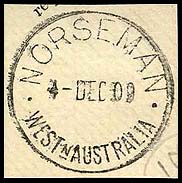 4 December 1909. Premier Auctions. |
Paddington (Sore Foot Rush then Gudarra). Paddington was located about six miles north of Broad Arrow. It was called Sore Foot Rush until 4 February 18997 when the town was gazetted. It later changed name again to Gudarra in 1912 in the Commonwealth's attempts to avoid duplication of names. A RMB was opened in November 1896 and this was converted to a Post & Telegraph Office on 15 November 1897. The Office was closed on 30 November 1911. The gold mine was located about half way between Kalgoorlie and Menzies. |
|
A rubber oval POST & TELEGRAPH OFFICE date stamp (RO2-P&TO) was issued to the office:
|
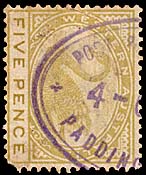 Unknown date. |
|
A Post and Telegraph Office was opened at Pindinnie on 1 April 1897. There is no record of a date stamp being issued to Pindinnie for use with the telegraph network. |
|
A Telegraph Office was opened on 1 May 1897. Five months later, it was upgraded to a Post and Telegraph Office in October. The Office was closed on 30 November 1899 and replaced by Murrin Murrin. |
Widgemooltha (or Widgiemooltha or Widgiemoola). Widgemooltha is about 55 miles (80 kms) south of Coolgardie on the Coolgardie - Dundas - Esperance line. The Coolgardie Pioneer of 29 July 1896 reported "The small township of Widgiemoola now presents an active appearance, being the rendezvous for speculators and others passing through to the Norseman. A progress committee is in the course of initiation, and correspondence is proceeding with a view to obtaining a telegraph station — a matter of importance to the district". The West Australian of 29 September 1896 placed the request in a fuller context: "Now that two new public house licenses have been granted for Widgemoola and that the buildings are to be started immediately, a general move is being made to the surveyed township. It is hoped by many that a Post and Telegraph Office will shortly be granted. The establishment of such premises would, it is pointed out, be very beneficial to the district and has been anxiously looked forward to by the residents". The Telegraph Office opened on Monday 18 October 1896. |
||
Personnel: October 1896: Mr G. Ferguson was appointed as the first Post & Telegraph Master. |
 Mr. A. W. Threadgold, Post and Telegraph Master. Scanned from Souvenir of the Postal, Telegraphic and Telephone Departments of Western Australia, GPO Perth Christmas 1898. |
|
A rubber oval Post & Telegraph Office date stamp (RO2 - P&TO) was issued for use with telegraphs:
|
 6 January ??. In red. |
|
|
A Receiver of Mail Bags was established at Lake Way in January 1898. The place was renamed Wiluna on 5 November 1900 and the Post and Telegraph Office was opened on the same day. |
|
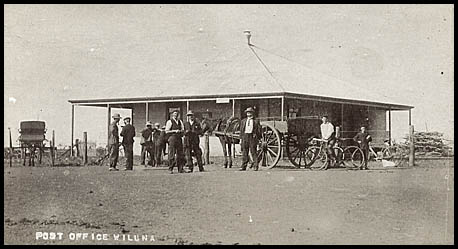 |
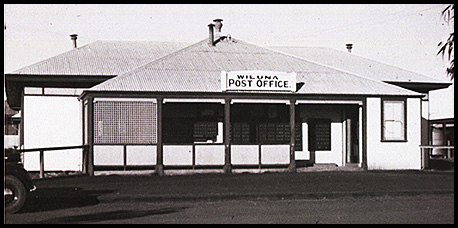 Wiluna Post and Telegraph Office about 1940. |
| An oval date stamp RO4-P&TO was issued to the Office. | |
|
|
|
 28 August 1912. Used on the reverse side of an OHMS registered cover sent from Perth to Wiluna where an UNCLAIMED handstamp was applied in black together with a violet DLO handstap with internally rounded corners. Franked with a 1d red and 3d brown Swans punctured with large OS. Has an oval DEAD LETTER backstamp for GPO Perth. The envelope still contains the original document informing George Cheetham that the Minister "claims an interest as mortgagee in Land". |
|
Yerilla is just north east of Niagara. Gold was discovered there at the Mount Catherine mine in January 1895. A Receiver of Mail Bags was opened in February 1896. The telegraph line was connected at Yerilla on Tuesday night (16th) and so the Post & Telegraph Office was opened on 17 February 1897 In a temporary location). Materials with which to build the Post & Telegraph Office arrived on 15 March 1897 and construction started on the following day. It was anticipated that the building would be completed before the end of April. BUT, in July 1897, a tender was accepted from Mr. McInnes for the sum of £460 to construct a Post and Telegraph Office. The North Coolgardie Herald of 11 January 1897 recorded for its readers "It is to be hoped that the Postmaster-General will open a Money Order Office at Yerilla soon after the telegraph line reaches us. A bank is very much needed here too as there is a large district to serve, and great inconvenience is experienced by business people on account of having to send cheques to Coolgardie and Menzies to be cashed". In November 1897, Mr. H. Gregory, the Member for North Coolgardie asked the Postmaster-General to open a Money Order Office at Yerilla.
That office was closed on 31 December 1899 - mainly due to the depression and the consequent migration of miners to other areas and hence the lack of support for the public battery which had been installed for gold processing. It must have reopened at a later date because date stamps are known for 28 August 1907 and 1 May 1913. Yerilla is now a Ghost Town. |
|
The Office was issued with a Post & Telegraph rubber oval date stamp.
|
 8 September 1899 - about 3 months prior to Office closing. |
|
Yundamindera is close and south west of Mount Margaret. During the visit of the Warden on 3 December 1900, it was agreed that the name The Granites was not sufficiently reassuring for a gold mining centre and so it should be changed. The Warden suggested that, if a local aboriginal name could be found, bearing a suitable English interpretation it would help the local nomenclature and prove acceptable in many other ways. After several suggestions, the name Yundamindera was selected and gazetted in 1903. Nevertheless, the aboriginal name was used from at least June 1901 when town lot 21 was gazetted for the Amalgamated Workers Association. In November 1901, townsite boundaries of Yundamindera (The Granites) were extended. Hence the commonly referred to 1903 date for the change of name may be incorrect. A contract to construct the Post and Telegraph Office at Yundamindera was let about mid 1900. By 1 December - good and bad news in the Menzies Miner: "The contractor for the erection of the Post and Telegraph offices has made rapid progress with the work up to date and it was expected that the buildings would be ready for transaction of public business this day week but, on Saturday last, word was received to stop the work. The trouble is all about the buildings having been removed on to the wrong block of land. This block was reserved for a resident in lieu of an area granted for business in the earlier days of the Granites, and some distance away from the subsequently selected townsite. Though the reserved ground was not occupied by the person entitled to it, still someone has blundered in inducing the Department to occupy it before securing absolute control over it. To again shift the building would entail an expense that is not justifiable. It is said that the Lands Department had notice of the surrender of the block, then what is the matter with completing the building where it is and let us have the facilities for postal business without further delay". A Post & Telegraph Office was first opened at The Granites on 10 December 1900. The Telegraph office was renamed Yundamindera from The Granites soon after. The article in the North Coolgardie Herald of 13 December 1900 reported that "The Post and Telegraph Offices shall remain upon the site where they were started to be erected. The work has gone on rapidly since instructions to that effect were received and we expect to be able to do business in the building by the end of the current week". On 13 June 1903, the Laverton & Beria Mercury reported that "Mr. C. Cooper, of the local Post and Telegraph Office, who recently spent a week or two in the Laverton Hospital suffering from pneumonia and who is at present recuperating his health at Mandurah, has received instructions to proceed to Yundamindera at the termination of his vacation to take charge of the Post and Telegraph Office at that place. His many friends in Laverton wish him every success". |
||
The RO6-P&TO date stamp issued to the Office:
|
 1 May 190? |
|
|
 24 July 1902. The Granites were not gazetted as Yundamindera until 1893. |
|


